African-skies

Panafrican Journal on Air Transport, Issue No. 52 : December 2022
In this issue: AFRAA Secretary General’s interview with Hermes
Liberalisation of African air transport under the AfCFTA
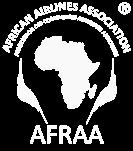
Preparing for the future, today AFRAA’s position on environment

Innovative leadership
 AFRAA’s
AFRAA’s
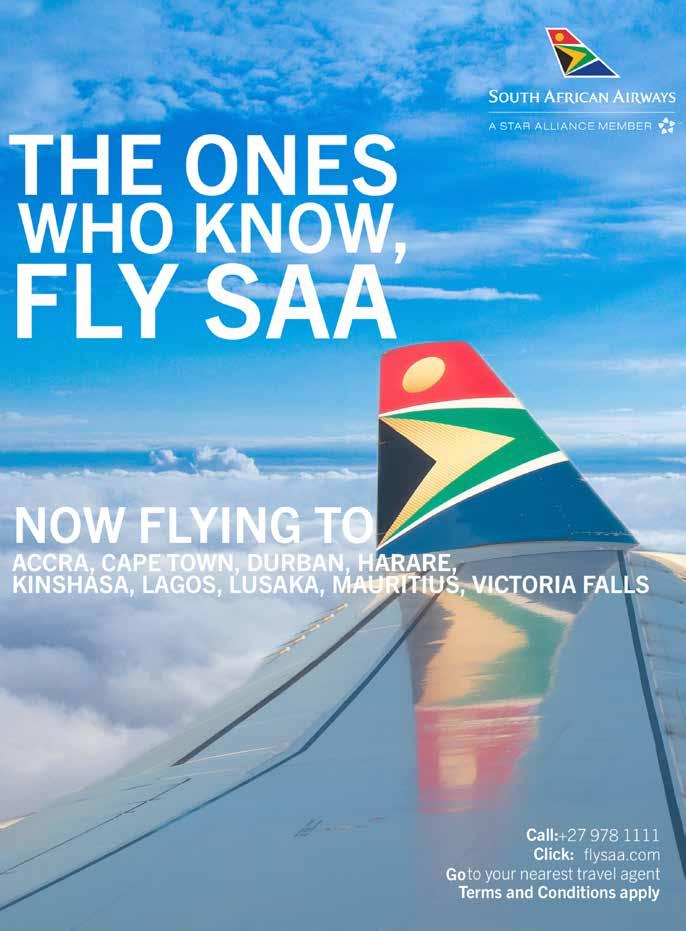
Road to recovery and sustainability of the airline industry
The airline industry’s recovery trajectory in 2023 has been positive and promising; however, African airlines are not yet out of the woods. According to AFRAA estimates, the year closes with traffic at 85.7% of the 2019 levels, while we estimate that intraAfrican connectivity has reached 94% of the pre-COVID levels as of November 2022. The revenue loss attributed to COVID-19 has reduced to US$ 3.5 billion in 2022 from the recorded US$ 8.6 billion in 2021 and US$ 10.21 in 2020.
As a matter of priority, AFRAA is preoccupied with actions for Africa’s air transport sustainability, much so that we spearheaded the first ever laboratory for the sustainability of the air transport sector in Africa. The laboratory approach was necessary to develop roadmaps for the sustainability of the air transport sector in Africa, which will be overseen by the Air Transport Sustainability Steering Committee (ATSSC). Through collaboration, AFRAA and the relevant stakeholders will work closely to achieve the Laboratory outcomes to ensure that Africa achieves
survival in the short term and its sustainability in the long-term.

To pair transport industry leaders from across the globe at this year’s AFRAA Annual General Assembly (AGA) & Summit, taking place from 11-13 December 2022 in Dakar, Senegal, will deliberate on the recovery and sustainability of the air transport industry in Africa. Topics have been carefully aligned to the main conference theme:” Acing the Road map to Sustainable African Aviation.” This will better prepare stakeholders to continue to rebuild Africa’s aviation to make the travel ecosystem more resilient and viable. Therefore, the Assembly is a critical forum for us to create the much needed environment for air transport business to thrive and contribute to the continent’s development.
Alongside the drive for sustainability into 2023 and beyond, AFRAA will continue to steer actions that will catalyse the airline industry’s growth through advocacy, partnerships for development, and data & intelligence – the three pillars of our mandate.
Mr. Abdérahmane Berthé AFRAA Secretary General

FOREWORD
We continue to steer actions that will catalyse the airline industry’s growth.
FOREWORD 1
SG’s interview with Hermes Insights on AFRAA’s perspective and actions on the sustainability of the aviation industry.
14
AFRAA’s position on environment



Leaders are focusing on reducing the environmental impact through technological improvement.

17
Airline passengers on their attitudes
Demand for air travel and enthusiasm to further embrace the mobile and touchless technologies that will make the journey as convenient and seamless as possible.
Innovative leadership
COVID-19 was a catalyst of the digital transition and a stimulator for innovative leadership.

Preparing for the future, today
We can never know what tomorrow will look like, scenario planning offers a chance to explore the possibilities.
Liberalisation of the African air transport under AfCFTA

The market is becoming steadily middle class, young, increasingly educated and by 2050 it will account for more than a quarter of the world’s working population.


The new shape of business travel

Changes brought about by the pandemic, and the new ways of working in many companies, are also creating new opportunities for business travel.
Environmental sustainability
The world is watching and waiting for major decisions that will protect our planet from the adverse effects of climate change.

African-skies AFRAA’sPanafricanJournalonAirTransport,Issue In this issue: AFRAA Secretary General’s interview with Hermes Liberalisation of African air transport under the AfCFTA Preparing for the future, today AFRAA’s position on environment Innovative leadership @AFRAA.AfricanAirlinesAssociation https://www.linkedin.com/company/african-airlines-association/ @AfricanAirlines www.afraa.org 2 | African-skies | DECEMBER 2022 07
24
04
10
Contents
28 FEATURES 26
Rolls-Royce: A partnership success story
Rolls-Royce is ideally positioned to steer Africa’s growing regional aviation sector in a sustainable direction over the coming years.
REGULARS
African-skies
PUBLISHERS
Camerapix Magazines Limited
EDITORIAL DIRECTOR
Rukhsana Haq
MANAGING EDITOR
Maureen Kahonge
SENIOR DESIGNER
Sam Kimani
PRODUCTION MANAGER
Rachel Musyoni
ADMINISTRATION | ADVERTISING
Azra Chaudhry (UK)
Rose Judha (Kenya)
African-skies is published quarterly for AFRAA by Camerapix Magazines Limited
Correspondence on editorial and advertising matters may be sent to either of these addresses
Regional International speaks to Kirsten Rehmann, Chief Executive Officer of Hahn Air on her achievement and her plans for leading the company into the future.
Accelerating the pace to aviation AFRAA is convinced that, the aviation industry commitment to net zero CO2 emissions by 2050 would require supportive government policies.

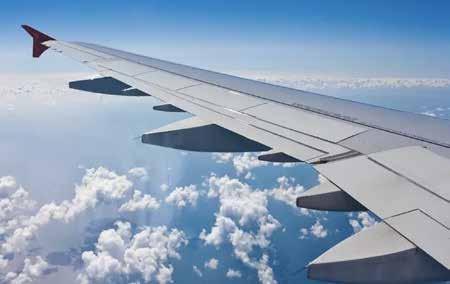
State
International routes and intra-African connectivity have improved since the COVID-19 pandemic period.
Editorial and Advertising Offices: Camerapix Magazines Limited
PO Box 45048, 00100, GPO Nairobi, Kenya
Tel: +254 (20) 4448923/4/5
Fax: +254 (20) 4448818 or 4441021
Email: creative@camerapix.co.ke
Camerapix Magazines (UK) Limited
32 Friars Walk, Southgate, London, N14 5LP
Tel: +44 (20) 8361 2942
Mobile: +447756340730
Email: camerapixuk@btinternet.com
afraa@afraa.org
Printed in Nairobi, Kenya
Message from AFRAA’s Secretary General 01 AFRAA diary 2022 at a glance. 40 All rights reserved. No part of this magazine may be reproduced by any means without permission in writing from AFRAA. While every care is taken to ensure accuracy in preparing African-skies, the publishers and AFRAA take no responsibility for any errors or omissions contained in this publication. © 2022 CAMERAPIX MAGAZINES LTD
of the industry
49
30 A rewarding journey
34
37
Interview with Mr. Abdérahmane Berthé, Secretary General, AFRAA

1. How do you define sustainability in aviation?
Mr. Abdérahmane Berthé, AFRAA Secretary General shares with Hermes insights on AFRAA’s perspective and actions on the sustainability of the aviation industry.
Aviation provides the only worldwide transportation network, which makes it essential for global business and tourism. It is vital in facilitating economic growth, particularly in developing countries. Air transport has become a driver of economic, social, and cultural development and has fundamentally changed how we travel, interact with others, and do business. Sustainability is defined simply as “meeting the needs of the present without compromising the ability of future generations to meet their needs.” Sustainability is a business strategy that drives long-term corporate growth and profitability by mandating the inclusion of environmental and social issues in the business model.
Building a sustainability strategy creates long-term value, improves efficiency and reputation, meets customer demands, and fosters the Aviation Industry’s resilience and longevity.
2. What are the key features of a sustainable aviation industry?
Sustainability is not just about the environment and society. It is about ensuring a prosperous future for the next generations.
Social, environment, and economy are the three features of the sustainable aviation industry. It is referred to as people, planet, and profits in today’s business environment.
3. How can the aviation industry best reduce its environmental footprint?
Air Transport contributes to 2% of humanmade CO2 emissions. The climate change trends put pressure on the sector to further reduce its modest share of CO2 emissions faster. ICAO Assembly adopted the Carbon Offsetting and Reduction Scheme for International Aviation (CORSIA).
We believe that the aviation industry will contribute to protecting the environment better with coordinated efforts in line with five pillars:
- Continuous Fuel Efficiency Improvement through New Technology.
- Alternative Fuel.
- Implementation of Fuel Conservation Initiatives in Operations.
- Air Navigation Infrastructure.
- CORSIA.
4. How will investments in sustainability impact the efficiency and profitability of aviation?
Aviation sustainability, in addition to addressing the industry’s environmental
INTERVIEW 4 | African-skies | DECEMBER 2022
impact, focuses on the survival and success of the aviation value chain.
To achieve the five pillars and positively impact efficiency and profitability requires investment in new technologies, alternative fuel, efficient infrastructure, and cost-saving competitive operations. Airlines need finance to invest in the modern, efficient fleet and relevant technologies that will make them competitive and sustainable. Aviation and tourism infrastructure investments are also required to boost the sector’s total development.
5. What are the industry’s best practices, already in place, that improve sustainability?
The good thing is that, in aviation, best practices are not traded secrets. They can be easily accessed and learned from.
The African Continent will have to learn from other regions where airline ownership limits are relaxed and foreign equity capital encouraged and not frowned upon. A deliberate policy to privatise state-owned airlines and invite foreign investors to take a stake will attract the capital and managerial expertise needed to run such airlines professionally. Airlines that are efficiently and profitably run are sure to be sustainable, provided the right regulatory environment is created to support business. This is the trend in many parts of the world.
On economic sustainability, consolidation and collaboration are crucial elements in the success of the African airlines. Airline consolidation across other regions has positively impacted the growth and sustainability of the airline industry. In the African context, the ripple effect of strengthened collaboration amongst airlines will be an increase in the industry’s contribution to the sustainable development of Africa. The engagement of states, airlines, and all relevant
stakeholders is necessary to achieve the required outcomes on airline consolidation in Africa effectively. On social sustainability, industry stakeholders across the globe are taking various actions to address gender diversity and develop the Next Generation of Aviation Professionals (NGAP) to meet the African global needs of the aviation industry of tomorrow. The development of skilled aviation professionals in Africa’s aviation and aerospace industry is critical as a large contingent of the current aviation professionals will retire, and aviation growth will require more qualified and competent professionals. The continent can train, develop and groom youth.
6. How can these best practices be fully implemented throughout the industry?
The acceleration to aviation sustainability will be realised if Africa allows the private sector to drive the commercial side of the business. At the same time, governments focus on enacting the enabling regulations to support the industry.
7. What are the regulatory impediments to increasing sustainability?
African aviation sustainability renaissance began with adopting the African Union (AU) Vision 2063, a continental development roadmap. Among the flagship projects in this document are the Single African Air Transport Market (SAATM); the African Continental Free Trade Agreement (AfCFTA); and the Protocols on the free movement of people and goods – three inter-related projects aimed at liberalising the air transport market, facilitating trade and the movement of people across borders.
To ensure the successful implementation of all three projects, conscious efforts are being made to put the regulatory framework and institutional structures in
place and to disband or amend national regulations that may not align with the letter and spirit of the AU Agenda 2063 and these flagship projects.
8. How can regulations incentivize and facilitate the aviation industry to be more efficient and more sustainable? The full implementation of the Yamoussoukro Decision (YD), AfCFTA, and facilitation of mobility through visa and passport protocols will guarantee aviation sustainability in Africa.
Harmonisation and implementation of appropriate policies and regulations are essential for the oversight of the AUC Agenda 2063 projects which will spur the sustainability of the air transport sector in Africa. Governments, Development Financing Institutions (DFIs), and other partners should support the efforts to implement all the regulations and set up functional structures.
9. How can industry participants, including airport, airlines, and air navigation providers, cooperate to improve sustainability?
Aviation has traditionally been a business that collaborates and coordinates to provide transportation services. Historically, airlines work with governments, airports, air navigation service providers, civil aviation authorities, tourism organisations, safety/security institutions, and other sectors.
Indeed, collaboration has seen the aviation industry agree on CORSIA to address the global environmental challenges instead of the earlier unilateral regional/country measures that would have been expensive and chaotic.
AFRAA believes that aviation ‘talks too much to itself’ and excludes other relevant players that influence the industry.
As the leading air transport body on the continent, AFRAA is conscious of this reality and has decided that in 2022, it will
INTERVIEW 5
Author: AFRAA
begin to change the narrative and establish broader consultation with all stakeholders for the industry’s good. In furtherance of this, AFRAA organised in June 2022 a ‘Laboratory’ of relevant players to consult broadly on critical issues of the aviation, trade, tourism, financial and regulatory sectors. The LAB brought together government, international development partners, aviation entities, trade and tourism organisations, financiers, regional economic communities, and selected consumers of air transport services. The laboratory developed roadmaps grouped under five projects that deliberated on out-of-the-box solutions on specific subject areas, including fuel and customs taxes, high taxes and charges, navigation – Free Routing Area (FRA), implementation of the Single African Air Transport Market (SAATM) and partnerships between airlines, hospitality and tourism bodies to improve intraAfrican tourism. The roadmap, which will be tabled for adoption by AU Policy Organs, shall be monitored, assessed, and reviewed by a multi-sectoral steering committee coordinated by AFRAA.
10. Sustainability is often thought of as a long-term goal, but what three key changes can the aviation industry implement within the next five years to increase sustainability?

A sector struggling to survive will find it difficult to focus on the long-term environmental goals that do not yield short-term visible results. This does not mean the environmental priorities are less critical.
The aviation world can do more by ensuring that all regions have viable and sustainable aviation businesses in the first place. Particularly in the developing world, where connectivity and mobility are limited, costly, and local airlines cannot sustain their businesses, there is a need for stakeholder collaboration to address some of the bottlenecks.
At the same time, governments should prioritise aviation and support the industry with the right laws that guarantee market access, capital access, and capacity development.
Finally, the efforts made by African states under the leadership of the African Union to implement SAATM and AfCFTA and facilitate the movement of people and goods are giant steps toward aviation sustainability in Africa.

INTERVIEW 6 | African-skies | DECEMBER 2022
Preparing for the future, today
We can never know what tomorrow will look like, scenario planning offers a chance to explore the possibilities. We examine potential paths for the future and how they could impact travel.

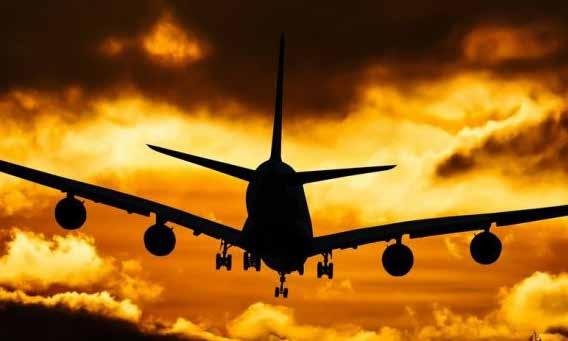

While the acute phase of the pandemic appears to be passing in many regions, the path towards a healthier and growing global economy remains tentative. COVID-19 continues to create uncertainty across all industries, and travel is no exception. What is encouraging is that there are many positive signs of recovery, with global travel search data almost back
at pre-pandemic levels, and with bookings steadily rising. However, this is no time for complacency, with the future shape of the sector still unclear.
It is therefore incumbent upon us, and other global organisations, to seek to understand the major drivers of change which are likely to shape the future. This is why already last year we commissioned scenario experts Stratforma, the experts in scenario planning and advisory consultancy, to work in partnership with us and explore different scenarios to help us understand how travel may evolve in the coming years.

FEATURE
7
Technology will be the key enabler to help the industry recover and develop.
The Scenario Planning methodology has been identified as one of the best approaches to address critical uncertainty around the future. However, while this type of work is vital to anticipate the emerging challenges and potential opportunities and to stress-test and re-evaluate our strategy, it is important to note this is not forecasting. We are not making predictions, but instead understanding the trends and drivers that are likely to shape the future.
Before we move on to the outcomes –a little about the process. During this exercise we hosted interviews with thought leaders, both from within and outside the travel industry, seeking expertise, views and unique perspectives on the future. This allowed us to identify more than 100 forces likely to impact travel in the coming decade. Following a process of selection, aggregation and evaluation, the 14 macro technological, economic, environmental and political (STEEP) pressures with the strongest impact on travel were identified. These included an increase in protectionism, disruptive natural events, the growth of the internet of things and the next wave of digital engagement, among others. Some of these we have some influence over while others we do not. With this information, future scenarios were codified along two axes of uncertainty: with drivers of demand ranging from increasing consumerism versus more values-based decisions along one, and a world which is less open versus more open along the other. These ‘critical uncertainties’ have shaped the main thrust of our analysis. In this context, consumerism is taken to mean a desire for consumption, personalised experiences, and gamification while a values-led mindset sees demand shaped by concerns, like sustainability, conscious consumption and political activism.
More open is taken to mean a commitment to global trade, freedom of movement of people, data, goods and capital, with porous borders and a commitment to a rules-based global order. Whereas less open is the antithesis, meaning a move toward nationalism, economic selfreliance, greater friction and stronger border controls.
Plotted on these axes, we can see the following four potential macroeconomic scenarios:
The most likely future will be a combination of these scenarios, drawing on elements of each. With dozens of forces pushing and pulling the world

With so much uncertainty – how will we prepare?
We believe that demand for travel will continue to grow, as the current data and evidence suggest. As restrictions have lifted, we have seen a rise in demand, demonstrating an appetite for travel that remains unwavering. However, we know change is constant, so what we see today may be very different from what we see in the longer-term. Why, where and for how long we travel is likely to shift.
With this in mind, we have identified four areas of focus we believe will benefit Amadeus, whatever tomorrow brings.
in different directions, no single trend or scenario is likely to dominate. We also cannot expect uniformity in terms of geography, with different outcomes expected across different continents. Nonetheless, as an industry we must be ready to respond to whichever scenarios we find ourselves confronted with.
As the global centre of gravity of the world’s economy continues to shift, we will work to reinforce our business in Asia to access the growth potential of the region. We will continue to strengthen our footprint, working to develop local relationships and adjusting our portfolio to meet the specific needs of our partners.
8 | African-skies | DECEMBER 2022 FEATURE
And around the world, we will continue seeking to secure market access to increase our ability to operate in a range of geographies.
Technology will be the key enabler to help the industry recover and develop. We will work to integrate with the digital giants –a process we have embarked upon as we migrate our cloud services to Microsoft. As an industry, we will see the wider adoption of digital payments and biometric data, for example.
There is a growing demand – from consumers, travellers and governments – to make travel more sustainable. To facilitate this, we will work to enrich our IT solutions portfolio in fundamental areas, optimising our operations for key players and offering them enhanced technology to support the green transformation. Also, requirements from an increasingly less open world (‘blockism’) need to be taken into account in future planning.
Finally, Amadeus will continue work to develop our businesses to help our customers serve the end traveller. Including a greater focus on our ability to distribute leisure content, including experiences, while also targeting new leisure-oriented travel resellers, including lifestyle brands and super-apps. We will continue to have a traveller-centric model, making tangible improvements to each travel experience.
This is just the start of an ongoing journey. Even as we take the steps outlined above, the market continues to evolve, and we must be prepared. Amadeus will continue to assess the world around us, supporting our customers as their strategies evolve. However, one thing is constant: we will always focus on the traveller. Only by doing so can we renew travel and harness the growth opportunities for travel in the decade ahead.
This is the first in a series of blogs that Amadeus will be publishing around scenario planning.
Author: Amadeus
Digitalizing engine services

The future of engine services is digital. As a global leader for customized solutions for aero engines, MTU Maintenance continues to pioneer new technology. Our growing portfolio consists of a number of digital services, including our highly-advanced maintenance costing and planning tool, CORTEX. Our engine experts’ know-how and artificial intelligence allow for tailored, data-driven decision making. As a result, you benefit from optimized, cost-effective maintenance strategies that fit your needs. Contact us and find your solution today.

9 FEATURE
www.mtu.de/en
Maint_E_180x115_African_skies_202210_01.indd 1 01.09.22 11:41
Proud partner of AFRAA
Liberalisation of the African air transport Sector under the African Continental Free Trade Area (AfCFTA) Agreement in Africa
1. Introduction
The Agreement establishing the African Continental Free Trade Area (AfCFTA)1 entered into force in May 20192, and now has 54 signatories and 44 State Parties3. The start of trading under the AfCFTA was launched from 1 January 20214. The AfCFTA Agreement also includes the Protocol on Trade in Services (hereinafter “AfCFTA Protocol on TiS”). To Africa’s general public and businesses across the continent, the AfCFTA is considered a catalyst for growth: it aims to create a market environment that promotes certainty, predictability, and transparency, and leads to reduced trade and transaction costs. Africa’s market of 1.2 billion people and US $2.6 trillion in GDP is expected to grow to as much as US $16 trillion GDP and 2.75 billion people by 2060. This market is becoming steadily middle class, young, increasingly educated and by 2050 it will account for more than a quarter of the world’s working population.
Five (5) priority services sectors (Business; Communication; Financial; Transport, and Tourism and Travel), were selected as the subjects of the first round of liberalisation under the AfCFTA trade in services negotiations5. The choice of these sectors was
strategic: first, communication, financial and transport services are backbone or infrastructural services to many economic activities, with business services (particularly professional services) substantially contributing to services delivery through the movement of persons; second, most African countries have liberalised tourism in some form either in the WTO General Agreement on Trade in Services (GATS) or in their Regional Economic Communities (RECs), making it the most liberalised of the services sectors and presenting “low hanging fruit” in terms of the potential socio-economic impact on micro, small and medium sized enterprises (MSMEs), women and youth.6
The transport services sector comprises of air transport, land transport (both road and rail), maritime transport, pipeline transport and space transport. The transport services sector acts both as an enabler of trade in both goods and services, and a key factor in the facilitation of trade in general. The success of the AfCFTA partly hinges on establishing an efficient, cost-effective transport sector because transporting people, goods and services at competitive rates will foster the growth of intra-African trade.
1 Agreement establishing the African Continental Free Trade Area available at: https://au.int/sites/default/files/treaties/36437-treaty-consolidated_text_on_cfta_-_en.pdf Thirty days after the 22nd instrument of ratification was deposited.
2 Thirty days after the 22nd instrument of ratification was deposited.
3 State Parties are signatories that have ratified the AfCFTA Agreement.
4 Thirteenth extraordinary session on the AfCFTA: The Assembly of the Union adopts decision on the start of trading | African Union (au.int)
5 Assembly/AU/Dec.690-712 (XXXI) found at 36130-assembly_au_dec_690_-_712_xxxi_e.pdf
6 Beatrice Chaytor, Creating a Single African Market on Trade in Services: Negotiating the Schedules of Specific Commitments under the Protocol on Trade in Services, Tralac Newsletter, Issue 14, October 2019, available at tralac Newsletter | October 2019 (mailchi.mp)
10 | African-skies | DECEMBER
FEATURE
2022
Symbiotic relationship between trade and air transport

Together with associated logistics services, air transport services are essential for the development and optimal functioning of regional value chains envisaged under the AfCFTA. A well-functioning air transport service sector also delivers positive effects on intra-African passenger travel that is likely to spark growth in education, healthcare, and tourism services. However, intra-African trade has largely been constrained by the state of air transport services across the continent. Africa has 925 airports, out of which 122 are considered international airports. Africa’s air transport network includes a total of 14,762 air routes (connecting each airport with the other 121 airports).7
But current air travel route networks are inadequate and air fares are high compared with those in other regions of the world. In 2019, air transport accounted for only 0.09% of intra-African freight transport.8 The African airline industry supports more than 6.2 million people in Africa directly and indirectly, including in tourism and other sectors. Tourism alone accounts for 8.5 percent of Africa’s GDP, and as much as 38 percent in some small island countries.9 COVID-19 has severely disrupted these service sectors, and generally the continent lacks effective and affordable air connectivity.10 In many cases, airport and air traffic management infrastructure are also inadequate for the growth that is expected to take place over the next 40 years.
That growth is likely to be driven by the implementation of the Single African Air Transport Market (SAATM) and the AfCFTA Protocol on TiS. The AfCFTA Protocol takes a hybrid approach to liberalisation, on the one hand, State Parties make specific commitments to open up service sectors through the


11 FEATURE
Author: Beatrice Chaytor, AfCFTA Secretariat
Author: Emily MBURU-NDORIA
four modes of supply, and on the other hand they agree to cooperate on broad regulatory frameworks.11 A similar approach is taken as the GATS, so the Protocol restricts air transport services to those affecting aircraft repair and maintenance services and selling and marketing of air transport services.12 It specifically excludes air traffic rights and services directly related to the exercise of air traffic rights. Since both the SAATM13 (which deals with air traffic rights) and the AfCFTA are flagship projects of the African Union, cooperation and joint implementation of SAATM and AfCFTA Protocol on TiS specific commitments in the air transport sector will be instrumental in aligning the two initiatives. The AfCFTA Protocol specifically references the Yamoussoukro Decision (YD) in its preamble, highlighting the significant contribution of air transport and SAATM in particular to boost intra-African trade and the AfCFTA in particular. Moreover, in Article 26.1 (c) reference is made to an Annex on air transport services as one of the legal instruments to be outlined under the Protocol.
According to UNECA, implementation of AfCFTA would double air cargo transport from 2.3 to 4.5 million tonnes.14 Air traffic is therefore expected to double in 2030 compared to 2019, with the AfCFTA requiring 254 aircraft by 2030, and the estimated cost of required aircrafts being estimated at US $25 billion.15 The largest demand for aircraft to support the AfCFTA is within West Africa (13.5%). Demand from North to West Africa is 15.2% and within Southern Africa is 12.2%.
Future air transport aervices shaped by the AfCFTA protocol on trade in services
The Schedules of Specific Commitments of State Parties in the five priority sectors that have recently been adopted by the AfCFTA Council of Ministers provide significant tailwinds for the air transport service sector, and will complement the tariff schedules in goods being implemented by State Parties, as the demand for air transport services to ship goods across the continent grows. The opportunities provided for increased trade in manufactures and agri-business means growth in economic activities and in job creation. Thus, increasing investments in vital infrastructure such as airports, warehousing and cargo aircraft will help African entrepreneurs, who trade in agricultural and food products and medicines requiring cold chain, storage, and long-distance transportation to access the markets of their trading partners on the continent. Such infrastructure will unlock Africa’s trade potential under the AfCFTA, leading to improvements in airport facilities and security, and streamlined cargo handling procedures.
To complement the market opening commitments a regulatory framework on air transport services will be developed as envisaged under the Protocol reducing the impact of the diversity of national regulatory regimes, by providing key elements for harmonisation across the countries. The development of such a regulatory framework will be informed by developments in the RECs as well as continent-wide legal instruments
such as the YD framework. Trade in air transport on the continent is governed by an elaborate structure of bilateral air service agreements (BASAs) based on reciprocity – the granting of traffic rights to contracting states. BASAs determine the degree of market access and provide rules that give airlines the rights to fly on specific routes, define the capacity of designated airlines and limit the capacity of airlines from third countries. The system thus imposes a set of country-specific quotas in each market, as competition on each route is limited to suppliers designated by the relevant BASA. This can result in underdeveloped networks and a lack of competition, and leads to higher fares. Open skies agreements on the other hand, such as the AfCFTA Agreement and SAATM, remove restrictions on fares, capacity, frequency and aircraft type for designated airlines.16
Effectively the regulatory framework under the AfCFTA Protocol on TiS will seek to promote and guarantee free and fair competition in air transport services, and support the market access and national treatment commitments undertaken by State Parties in their schedules of specific commitments. The idea is that the specific commitments by State Parties and the regulatory framework in the air Transport sector should support ease of market entry by removing restrictions such as discriminatory licensing, giving other African service suppliers the opportunity to compete equally with domestic suppliers and as far as practicable, ensuring they are treated no less favourably than domestic suppliers.
8 Ibid, Chapter 5, pp 132-133.
9 Ibid.
12
12 | African-skies | DECEMBER 2022 FEATURE
7 Africa’s Services Trade Liberalisation & Integration under the AfCFTA, Assessing Regional Integration in Africa (ARIA), Volume X, UNECA, 2021, Chapter 5, available at https://repository.uneca. org/handle/10855/46739.
10 The African aviation industry recorded revenue loss of US$ 8.2 billion in 2021. ARIA X, pp. 11 AfCFTA Protocol on Trade in Services, Articles 18-22.
Ibid. Article 2 paras. 5 and 6. 1335 countries are signatories to the Solemn Declaration.
In an attempt to fast track the start of commercially meaningful trade under the AfCFTA, the Guided Trade Initiative (GTI) has been established, to enable those countries that are better prepared to begin to trade with each other.17 Eight State Parties are participating in the GTI,18 whose aims include (i) to allow commercially meaningful trading under the AfCFTA; (ii) to test the operational, institutional, legal and trade policy environment under the AfCFTA; and (iii) to send an important positive message to African economic operators that trade under the AfCFTA is possible and beneficial. About 100 goods are subject of trade under the GTI, which will be reviewed annually to expand the participating countries and available products eligible for trade. Shipments under the GTI have already commenced, with tea exports from Kenya to Ghana, transported by air, being the first among these.19
The Council of Ministers has also mandated the AfCFTA Secretariat to expand the GTI to include trade in services, incorporating the priority services sectors.20 The potential for services trade under the GTI is huge, and will feature services sectors in their role as enablers for trade in goods (transport, finance, communication services) as well as trading in services in their own right (professional, tourism and travel services); in both
aspects air transport services have a huge role to play.
Conclusion
The liberalisation of air transport services as a trade-facilitating tool presents a game-changer for Africa’s trade. A key factor in determining growth of the African aviation industry will be the extent of air transport market liberalisation under both the AfCFTA and the SAATM. It is particularly helpful that transport is being negotiated in the current round of services negotiations, in which significant progress has been made. Specific commitments in transport services undertaken by State Parties will spawn investments in infrastructure that can address bottlenecks among African countries, enabling them to increase cross border trade in manufacturing and agribusiness, driving industrialisation.
Regulatory frameworks to support market access openings will also ensure a level playing field among airline operators and reduce transaction costs. If the opportunities for investment in air transport infrastructure can be captured, the continent will be transformed beyond expectations. As the Guided Trade Initiative gets underway and more transactions among the participating State Parties are concluded, the more business confidence will be generated about the AfCFTA, and more likely the success of the free trade area generally.
15 Ibid.
16 ARIA X, Chapter 5, pp.139-145.
13 FEATURE
14 African Continental Free Trade Area (AfCFTA) to significantly increase traffic flows on all transport modes | United Nations Economic Commission for Africa (uneca.org)
17 The AfCFTA Guided Trade Initiative - AfCFTA (au-afcfta.org)
18 Cameroun, Egypt, Ghana, Kenya, Mauritius, Rwanda, Tanzania, and Tunisia.
19 AfCFTA’s Guided Trade Initiative takes off, set to ease and boost intra-African trade | Africa Renewal (un.org)
20 Report of the 10th Meeting of the Council of Ministers, 7 October 2022, on file with the author.
AfCFTA is considered a catalyst for growth: it aims to create a market environment that promotes certainty, predictability, and transparency.
AFRAA’s position on environment
1. Introduction
Sustainability has become a major subject of concern within the global aviation industry. Leaders are focusing on reducing the environmental impact through technological improvement. Global warming, environmental degradation, climate change and depletion of resources are becoming widespread. In response, aviation is conducting business with the long term goal of reducing aviation’s net CO2 emissions to half of what they were in 2005, by 2050. Aviation aims to do this by focusing on technology improvements, operational efficiencies, infrastructure development and sustainable aviation fuels (SAF).
Air Transport contributes to 2% of human-made CO2 emissions. Though air traffic doubles every 15 to 20 years, the Aviation sector has developed a strategy to attain and maintain carbon neutral growth by 2020. Africa aviation share in the global CO2 reduction goals and AFRAA have been working with stakeholders in coordinating the African response. This policy paper summarises AFRAA’s position relating to the environment in Africa.
2. Africa status vis-à-vis the environment
In Africa, though the industry is growing, airlines’ share of global traffic has stagnated at around 2% for a very long time. In real terms, African airlines’ market share for intercontinental traffic has shrunk from 60% some 40-50 years ago to just about 20% in recent times and still shrinking. African aviation contribution to the global aviation emission of 2% CO2 is very negligible. However, as the potential for aviation growth on the continent is enormous, to the sector is proactively working on and promoting measures and programs to protect the environment.
3. AFRAA regional approach for environment
Climate change effects are more visible across the Continent. The southwards expansion of the Sahara, the changing rainfall
patterns, severe flooding and droughts are indications of global warming and environmental degradation.
Therefore, AFRAA strategy is to drive global aviation environmental initiatives with local targets and deliverables to ensure a sustainable industry. In partnership with other stakeholders, AFRAA 5 pillar approach to a improving the environment from the aviation perspective are as follows:
Pillar 1: Continuous fuel efficiency improvement through new technology
Encouraging airlines to invest in new technology and aircraft that are more efficient and emit less CO2. Striving to meet more stringent environmental SARPS and operations procedures aircraft will burn less fuel and consequently lessening their environmental footprint.

Pillar 2: Alternative fuel
Promote the adoption of the use of bio-fuel as one way to reduce the dependence on jet A1 from crude oil. In Africa, SAA pioneered the use of blend-in bio-fuel in a demonstration operations between Johannesburg and Cape Town. With Africa’s vast arable land, it could grow much needed by-products for bio-fuels.
14 | African-skies | DECEMBER 2022 FEATURE
Africa and African airlines should prepare for the use of bio-fuel as technology mature in the medium term.
Pillar 3: Implementation of Fuel Conservation Initiatives in Operations
Focused on maintenance, ground, and flight operations, AFRAA urges members to implement relevant fuel conservation initiatives to burn less fuel in operations, to emit less CO2 while reducing their fuel bills.

AFRAA is working closely with member airlines towards the implementation of fuel conservation programs in operations.
Flight Procedure Program (A-FPP) to assist the African States in designing the procedures at very competitive costs. These PBN procedures support the performance of safe Continuous Climb Operations (CCOs) and Continuous Descend Operations (CDOs) along Standard Instrument Departure (SID) and Standard Arrival Routes (STARs) while improving fuel efficiency in the TMAs.
It is AFRAA’s view that Air Navigation Service Providers (ANSPs) should provide flexible routings in clusters of airspaces with entry and exit points, taking advantage of the low-density flights across the Continent’s huge area. Flight operations along flexible routings exploit high altitude winds, reduce flight times, decrease fuel burnt, and limit CO2 emission significantly.
AFRAA urges airlines, ANSPs, and states to build on gained experience in the Atlantic Ocean Random Routing Area (AORRA) to extent flexible routing operations gradually in the continental airspace.
Pillar 5: CORSIA
Pillar 4:
Air Navigation
Infrastructure Stakeholders agreed to set as a priority the implementation of PerformanceBased Navigation (PBN) procedures in terminal areas (TMAs) at African airports. To support the deployment of PBN in TMAs, ICAO established the African
In 2016, the ICAO Assembly adopted the Carbon Offsetting and Reduction Scheme for International Aviation (CORSIA), to stabilise net CO2 emissions from international aviation from 2021. ICAO has now agreed that 2019 emissions will be used as the baseline for net CO2 emissions from international aviation. AFRAA actively participated in regional coordinated position of African States for CORSIA.
CORSIA has applied to international aviation since 1 January 2019 when all airlines were required to report their CO2 emissions on an annual basis. From 1 January 2021, international flights will become subject to offsetting obligations.
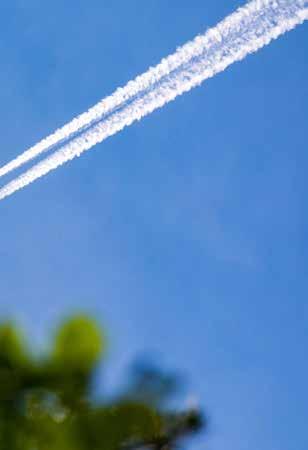 Author: AFRAA
Author: AFRAA
15 FEATURE
Sustainability has become a major subject of concern within the global aviation industry.
The CORSIA voluntary phase for states is from 2021 until 2026. As of July 2021, 106 states (including 17 from Africa) representing 77% of international aviation activity have committed to the voluntary phase.
From 2027 onwards, CORSIA comes into force and will be mandatory. AFRAA is encouraging more African States to sign up for the voluntary phase so as to test their monitoring and reporting efficiency and accuracy. This phase gives opportunity for participating states to make corrections and adjustments in readiness for the mandatory phase beginning 2027.
Industry capacity building, advocacy and sensitisation events by AFRAA and partners will continue aimed at assisting particularly airlines to better understand their role and obligations.
4. Conclusion
Climate change trends are a wake-up call for all economic sectors to take action and reduce human-induced CO2 emissions worldwide. Though air transport emission
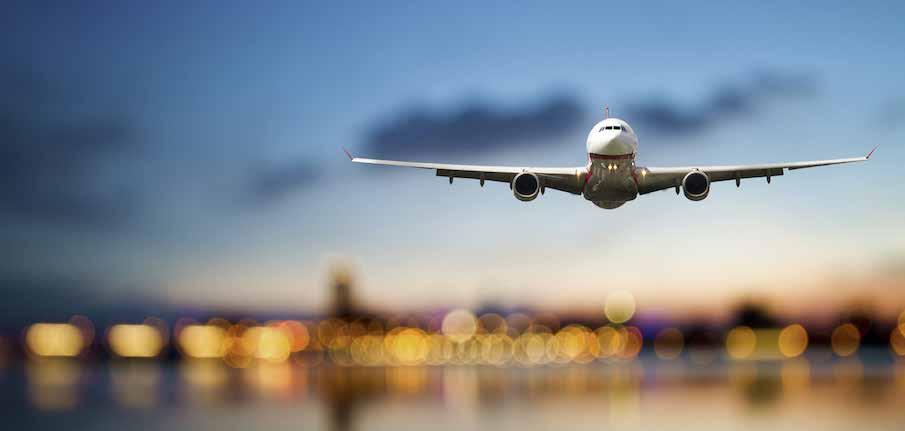
share is only 2% of the world’s CO2, the aviation sector has developed several initiatives to reach and maintain carbonneutral growth by 2020 and reduce aviation’s net CO2 emissions to half of what they were in 2005, by 2050, while air traffic increases.

AFRAA believes that African aviation will contribute to protecting better the environment; it requires that aviation stakeholders continue coordinated efforts
in line with the five pillars:
• Continuous Fuel Efficiency Improvement through New Technology;
• Alternative Fuel;
• Implementation of Fuel Conservation Initiatives in Operations;
• Air Navigation Infrastructure and;
• Carbon Offsetting and Reduction Scheme for International Aviation (CORSIA).
16 | African-skies | DECEMBER 2022 FEATURE
SITA worldwide survey of airline passengers on their attitudes and use of IT and mobile digital Technology in air travel
As we emerge from the COVID-19 pandemic, passengers are showing pent-up demand for air travel and enthusiasm to further embrace the mobile and touchless technologies that will make the journey as convenient and seamless as possible.
SITA’s 2022 Passenger IT Insights research reveals that passenger use of mobile devices increased for booking, on board the airplane, and for bag collection in Q1 2022 compared to Q1 2020, while automated gates saw increases in adoption for identity control, boarding, and border control.
However, health verification, still largely manual, is a pain point that has slowed end-to-end automation. Our survey finds reduced technology adoption in the early stages of the journey (check-in, bag tag, and bag drop) in favour of manual processing. Uncertainty about health requirements and travel rules has likely led passengers to seek more staff interaction when starting the journey. Even so, it is clear that the more technology there is during travel, the happier passengers are. The research unveils that two journey stages have seen particularly significant increases in positive emotions since 2016: identity control (up 11%) and bag collection (up 9%). These are also the areas where technology adoption has risen the most, driven by mobile and automated gates, with half of passengers now also receiving real-time information at bag collection on time until delivery.
Asked about comfort levels with biometric identification throughout the journey, passengers scored an average of almost 7.3 out of 10 (with 10 representing most comfortable), most likely reflecting their desire for ease of travel moving forward from the pandemic.
Passengers surveyed intend to fly more from 2023 onwards than they did prior to the pandemic, expecting averages of 2.93 flights per passenger per year for business and 3.90 for leisure. When weighing up whether to fly or not, the main barriers are ticket prices, health risks, and geopolitical risks. But before flying, passengers also consider sustainability. The initiative they would most value seeing from airports and airlines is the use of new IT to support sustainability, such as monitoring airport environmental performance to reduce emissions, and use of technologies to reduce fuel burn. Almost all passengers would pay on average 11% of their ticket price to offset carbon emissions from their flight.
Asked if the air transport industry is doing enough to become more sustainable, more than half of passengers either think not, or don’t know. The key takeaway is that there is room for improvement in the communication of industry sustainability initiatives and actions.
Methodology: Fieldwork for the 15th edition of the Passenger IT Insights was conducted globally in Q1 2022. The key findings are based on an online survey of 6448 respondents from 27 countries across the Americas, Asia, Europe, Middle East, and Africa. The number of respondents by country is relative to the amount of passenger traffic for each country, based on data from Airports Council International (ACI). Collectively, the respondents represent over 85% of global passenger traffic. Survey respondents were selected based on having traveled at least once in the previous five months. The main countries included: Australia, Brazil, Canada, China, Egypt, France, Germany, India, Indonesia, Italy, Japan, Kenya, Mexico, Morocco, Nigeria, Republic of Korea, Russia, Saudi Arabia, Singapore, South Africa, Spain, Turkey, UAE, UK, USA, Vietnam.
Herewith presented are the highlights of the analysis of SITA’s survey:
17 FEATURE
PASSENGER TECHNOLOGY ADOPTION
Technology adoption in 2022 reflects the pandemic’s effects on the passenger journey: Rates of technology adoption have remained relatively stable at each journey stage since the survey was last conducted in Q1 2020. However, there is a slight trend towards reduced technology usage in favour of manual interaction in the first half of the journey followed by increased technology adoption in the second half. Technology adoption at the check-in stage has decreased by 4% since Q1 2020, while the bag tag and bag drop stages have also seen decreases of 2 to 6%. Meanwhile, identity control, boarding, on board, border control, and bag collection have all seen increases in technology adoption of 3 to 5% from 2020. The overall lack of significant increase may be due to reduced travel during the COVID-19 pandemic, meaning passengers have not had the chance to familiarise themselves with new technologies. At the same time, due to the uncertainty around travel rules imposed by the pandemic, some flyers may have felt the need for more staff interaction at the beginning of the journey to ensure they were doing things correctly, but felt comfortable relying on technology in the second half.
Passenger technology usage preferences along the journey
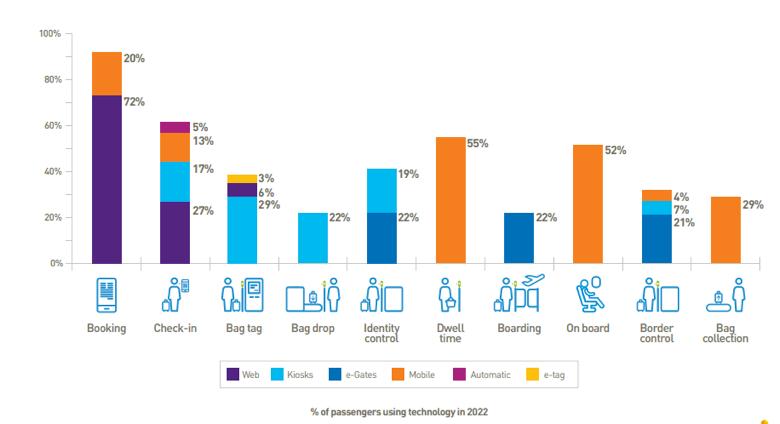

18 | African-skies | DECEMBER 2022 FEATURE
Health verification remains largely manual at the flight preparation stage, to understand COVID-19 verification requirements, most passengers (60%) actively researched the information, consulting sources such as government or airport websites, with nearly one quarter also asking others. At the same time, significant numbers of passengers received information on COVID-19 requirements directly from their airline, with 42% receiving this via email and 31% via the airline’s mobile app. At the stage of submitting COVID-19 documentation, just over half of passengers did so by manually showing it to staff. There was still some technology adoption at this stage, with just over one-third of passengers submitting documentation via an airline app and smaller numbers submitting via a third party app or self-service kiosk. The complexity of understanding ever-changing COVID-19 requirements is reflected in the high percentages of passengers who took multiple actions through various channels at each step. Over half of passengers who received COVID-19 information from the airline also did their own research online, and just over a third of those who submitted documentation via an app before check-in also underwent manual verification.
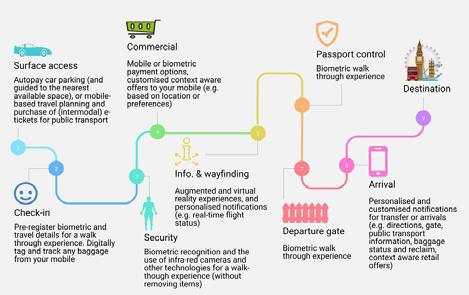

19 FEATURE
Technology adoption for health verification
Passenger journey
Mobile usage and real-time information growing at bag collection: The percentages of passengers who received information at bag collection via screen displays and public audio announcements have stayed the same since Q1 2020; however, a growing proportion of passengers are receiving notifications via their mobile devices (up 5% from 2020). Regarding the types of information passengers received, 57% were told belt numbers, and 50% were told time until delivery – the latter is up 8% from 2020, signaling a shift towards more real-time information being made available to passengers. Looking to the average number of checked bags per passenger, after steadily rising from 2017 to 2020 to reach 1.49, the figure dropped back down to 1.28 in 2022, a 14% decrease from 2020. This may be related to changes in airline pricing models for checked bags, as well as the shift towards greater proportions of domestic over international travel during the recent recovery period. IATA data shows that April 2022 traffic stood at -43.4% of April 2019 international traffic levels, but a significantly higher -25.85% for domestic.
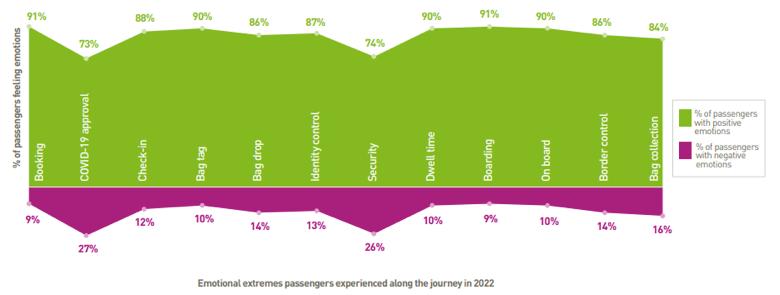
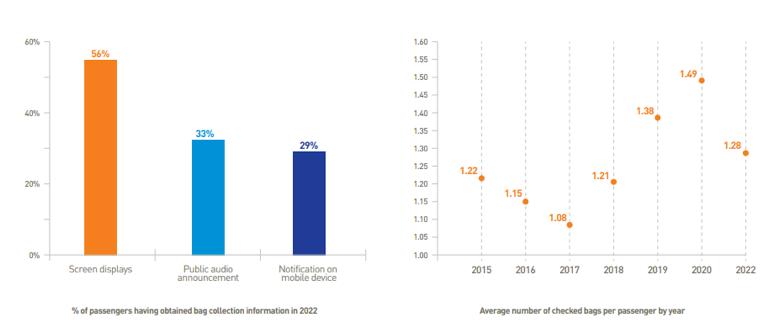
20 | African-skies | DECEMBER 2022 FEATURE
1 1. Source: IATA, “Strong International Traffic Propels Continuing Air Travel Recovery,” June 2022
Technology
Emotional extremes along the journey
adoption at baggage collection
Greater technology adoption correlates with more positive emotions at key travel steps: Passengers appear happier overall throughout the journey in 2022 than in 2016 (the last time this metric was taken into account), with three particular pain points from 2016 seeing significant increases in positive emotions. The following all saw shifts in favour of more positive emotions: identity control (up 11% from 2016), security (up 6%), and bag collection (up 9%). Of these stages, the two where emotions have seen the greatest positive shifts since 2016 are also among the stages that have seen the highest increase in technology adoption over the same period. In fact, in 2016, there was no technology adoption for either identity control or bag collection, whereas in 2022, 41% of passengers are using kiosks and e-gates for identity control and 29% are receiving mobile notifications for bag collection.
Frequency of flying pre-pandemic vs. post-pandemic
For recent travellers, demand has rebounded to – and even surpassed – pre-pandemic levels: Passengers report intentions to fly slightly more from 2023 onwards than they did prior to the COVID-19 pandemic. This holds true for both leisure and business travel, reflecting pent-up demand for travel following the period of disruption imposed by the pandemic. Passengers expect to take an average of 2.93 flights per year for business purposes from 2023 onwards, compared to the average of 2.73 flights per year taken before the pandemic. They in turn expect to take an average of 3.90 flights per year for leisure from 2023 onwards, up from 3.69 before the pandemic.
Note: the sample for this survey considers only individuals who traveled in Q1 2022, therefore representing the sentiments of those who were willing to travel before the wider lifting of travel restrictions.
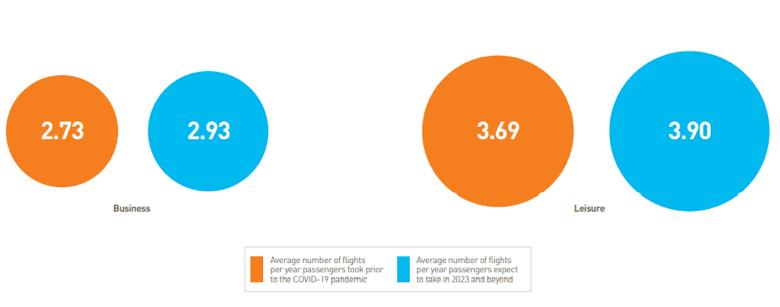
21 FEATURE
Current geopolitical and economic factors strongly influence anticipated barriers to flying:
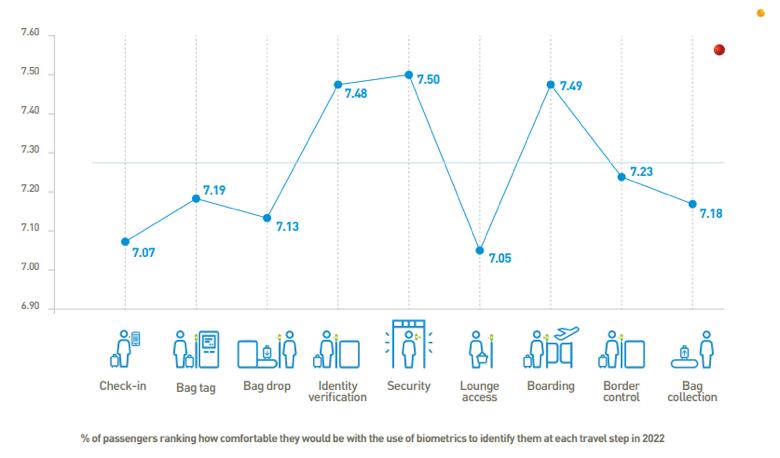

The top three barriers to flying in the future that passengers anticipate in 2022 appear to closely relate to current global geopolitical and economic factors. Ticket prices come out as the number one anticipated barrier, with close to half of passengers citing this as a concern. While ticket prices are always likely to be a barrier, this may be exacerbated by the current inflation and rising costs facing many countries. Concern over health risks, ranked as the second biggest barrier, is clearly linked to COVID-19, suggesting that concerns are likely to continue, even among those who have been willing to fly during the pandemic. Geopolitical risk comes third, with about one-third of passengers listing it as a top concern; this is likely related to current crises such as the one in Ukraine, which may be creating further global uncertainties around the possibility and safety of travel on an ongoing basis. Indeed, the latter is ranked even higher (second, surpassing health risks) in Europe, the region most affected by the Ukraine conflict. On the other hand, health risks outweigh both ticket prices and geopolitical risks for first place in Asia, the Middle East, and Africa, where COVID-19 restrictions remain in fuller force.
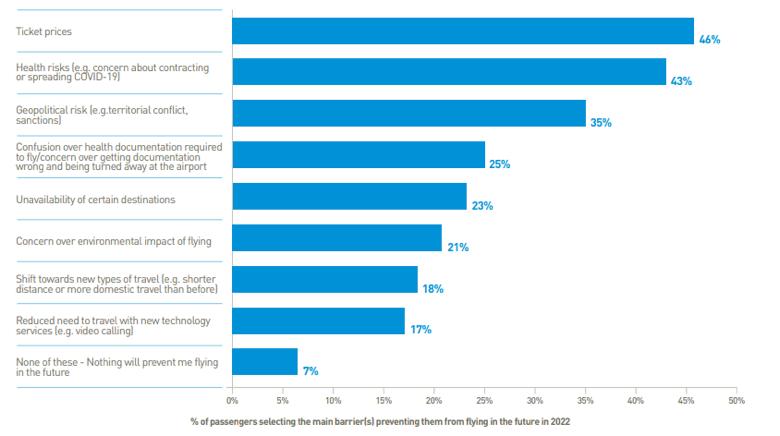
22 | African-skies | DECEMBER 2022 FEATURE
Passengers’ main barriers to flying in future
Author: SITA Author: SITA
Comfort levels with biometric identification vary along the journey: When scoring out of 10 how comfortable they would be with biometric identity checks at each stage of the journey, passengers appear relatively comfortable with the use of biometrics. Passengers ranked identity control, security, and boarding the highest, possibly because they already expect various checks to occur in these areas. Conversely, check-in, bag drop, and lounge access came out as the lowest ranked, perhaps because passengers do not see the value of biometric identification at these stages.
Top 3 Sustainability initiatives valued most by passengers


Growing interest in IT to support sustainability: Passengers have maintained from Q1 2020 the same top three sustainability initiatives they would value the most if undertaken by airports and airlines, with a strong interest in new IT solutions to support sustainability (valued by around half of passengers). On the airport front, this initiative has overtaken green airport infrastructure for first place (up 4% from 2020), suggesting all eyes are on the promises of technology to support concrete reductions to the environmental impacts of the industry. The continued sensitivity of passengers toward sustainable food options (47%), recycling, and water refilling stations are key areas of attention for the industry.
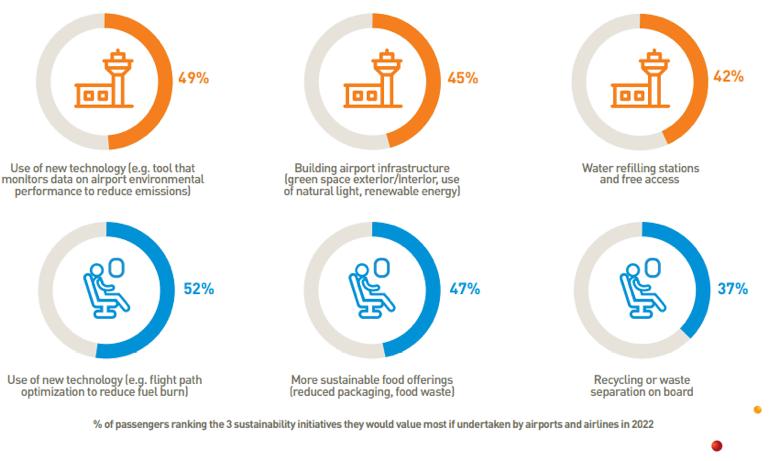
23 FEATURE
Innovative leadership: A key strategy amidst recovery


Over the last two years, COVID-19 on one hand, has been for some airline companies an era of stagnations and on the other hand an era of innovation and continuous improvement for others. In fact, some airline companies faced this disruptive change as a threat and a risk, while others as an opportunity to seize for reinvention. However, we cannot deny that COVID-19 was a catalyst of the digital transition and a stimulator for innovative leadership.
In this context, it’s worth mentioning that Royal Air Maroc (RAM), one of Africa’s leading airline organisations has set the bar high by making a pioneering initiative with its Digital Open Innovation Program that spread out worldwide in a few months. Indeed, this Program is a great example of self-leadership application.
During the pandemic, RAM's vision evolved from 2.0 to 3.0, and the Open Innovation Program was a successful strategic recovery initiative for the year 2022. The Program was a great initiative for the company to open to the startup ecosystem worldwide, seeking innovative ideas. In fact, more than 300 applicants varying from students, startups, and scaleups from around the world; Asia, Africa, America, and Europe, participated to the RAM’s challenges. Challenges include real time information, enhancing customer experience and operational efficiency, leveraging sustainability, etc., and led to build new organisational capabilities. In this context, the program has spread out globally, thanks to the synergy between RAM and their strategic partners, such as Innova Conseil which accompanied RAM’s teams with a selfleadership approach.
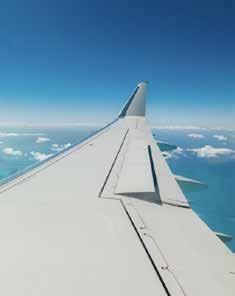
24 | African-skies | DECEMBER 2022 FEATURE


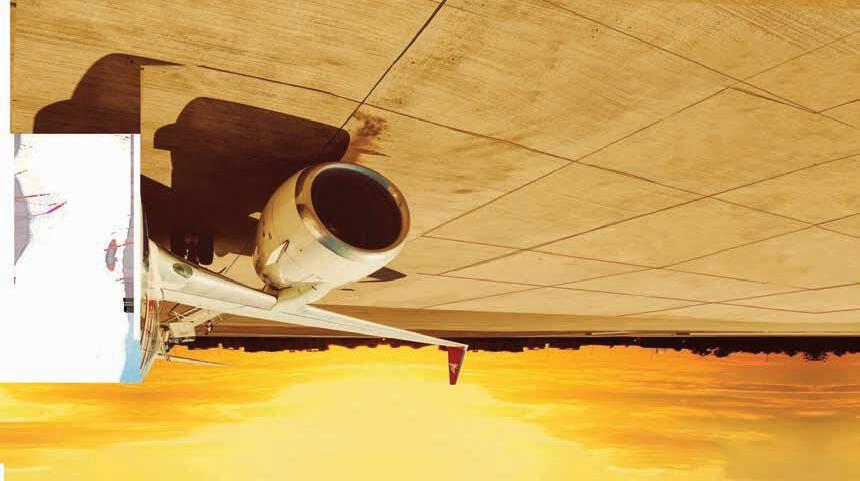
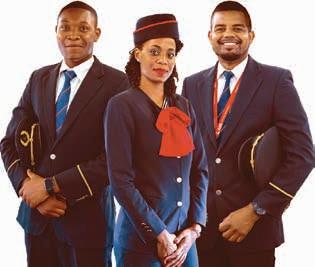



FEATURE
The new shape of business travel Sabre InsightsJune 2022
While leisure travel continues to lead the postCOVID-19 recovery, recent data indicates that the return of corporate travel is accelerating. In recent months, the difference in the recovery between corporate and leisure has narrowed significantly, presenting opportunities for travel management companies (TMCs) and other players in the business travel segment.
The reasons for the initially slower return of corporate travel were also explored in Sabre’s latest research study; after two years of relying on Zoom and Teams, most companies are now accustomed to, and dependent on, vir tual meetings. Many also have a conservative approach to duty of care and allow their staff to travel only when it is very safe; and some simply see virtual meets as a way to save costs.
On the other hand, during the interviews that Sabre conducted with airline and agency executives, it became apparent that the changes brought about by the pandemic, and the new ways of working in many companies, are also creating new opportunities for business travel.

26 | African-skies | DECEMBER 2022 FEATURE
In an era of remote, flexible work, travel is more important to business culture than ever before
There’s no doubt that the pandemic has brought about huge changes to working culture. We’ve all seen the power of technology in helping us stay connected and to keep business moving from afar. People are working from home, processes have been digitised, office space has been downsized, and many people used the opportunity to relocate away from their place of work. Sabre introduced a permanent ‘Work from Anywhere’ policy 18 months ago and has seen benefits in supporting work/life balance, improving productivity, motivation and job satisfaction.
Ultimately, people are spending less time in the office and with their colleagues than before the pandemic, meaning that companies have had fewer opportunities to cultivate their corporate culture and team spirit. Business travel for in-person meet-ups has therefore become key for companies to drive and maintain their corporate culture. As CEO of Amex GBT Paul Abbot wrote in a column, ‘The office used to drive culture. Now it will be travel.’
The lines will continue to blur, facilitating the rise in ‘revenge travel’ and the new ‘bleisure’
Pent-up demand to travel freely again has resulted in an increase in ‘revenge travel’ – the strong desire to travel even more than before the onset of the pandemic to make up for lost time. This desire to travel, combined with a newfound flexibility when it comes to remote work or learning, is expected to mean travellers may stay longer at a destination. Boundaries between work and travel are blurring as people take ‘workcations’ – taking longer trips and combining work with a vacation. Doors have opened on ‘dream’ trips that perhaps would not have been possible pre-pandemic, such as spending a month in the Caribbean, working during the week and taking advantage of the locale on the evenings and weekends.
Delivering the corporate travel experience of the future
To succeed in the current ecosystem, travel companies should take advantage of these emerging trends in the business travel space while supporting ‘traditional’ business travel as it makes its return. However, these trends add further complexity to the already complicated interplay between travellers and their employers, as well as TMCs and their suppliers and technology providers. Take ‘workcations’ as an example: There are considerable additional considerations with these – both in terms of traveller needs (e.g., type of accommodation, requirements such as high-speed internet, flexible cancellation) and for corporations, with impacts on duty of care, tax implications, etc. Added to this, business travellers will continue to expect more from their travel experiences, demanding highly personalised, flexible trips that offer the level of choice and control they’ve come to expect from interactions with onlinenative businesses, and this will need to be complemented with the high level of service, quality assurance and disruption management that customers came to appreciate during the pandemic.
Sabre is working on the right technology to support this evolution and to allow its customers to embrace new opportunities as they arise. Sabre believes there is enormous opportunity to make corporate travel better – through personalised offers, enhanced service, disruption management, customer identification, and loyalty. Sabre is focused on creating an open and multi-source ecosystem across a range of travel content, which the broader travel community can benefit from. Under this strategy, Sabre will focus on delivering the corporate travel experience of the future – which will include the enablement of highly personalised business travel offers, bleisure travel experiences, and technology that supports the most complex travel itineraries and most demanding customers.
 Author: Sabre
Author: Sabre
27 FEATURE
Aviation environmental sustainability in Africa

As global leaders converge at the Mediterranean Pavilion in Egypt for the UN climate change Conference (COP 27) from November 6th to the 18th 2022, the world is watching and waiting for major decisions that will protect our planet from the adverse effects of climate change. This edition of the climate change conference shall allow Africa to spotlight its special needs, circumstances and opportunities. Building on the outcomes and momentum of COP 26 in Glasgow, nations are expected to demonstrate at COP 27 that they can walk the talk by putting their commitments under the Paris Agreement into action in a just and equitable manner.
This is also an opportunity for the air transport sector in Africa to rise up to the occasion by designing and implementing adaptable decarbonizing policies in the industry. The global aviation industry contributes about 2% to global carbon emissions and there have been great strides towards cleaner skies and a greener environment. But it is not only Carbon dioxide that is an issue.
Author: Moses Ngwanah Chief Operating Officer GS Aviation, Madagascar
According to the Intergovernmental Panel on Climate Change (IPCC 2011), Aviation is responsible for 3.5% net of Anthropogenic ERF

28 | African-skies | DECEMBER 2022 FEATURE
GHG- Green House Gases (Carbon Dioxide-C02, Nitrogen-NOX, Fine particulate matter-PM);
Contrails and Aircraft Induced Cloud-AIC.
The global aviation industry has invested heavily in R&D as a means to reduce its footprints on global warming. In response to the need to reduce carbon emission while minimising market distortion, ICAO designed the Carbon Offsetting and Reduction Scheme for International Aviation (CORSIA) which is being implemented in 3 phases. But this market-based measure may not be sustainable in the long run, reasons for which the shift is towards:
I. Sustainable Aviation Fuels (SAF) which include Biofuels and Power to Liquid Fuels (PtL);

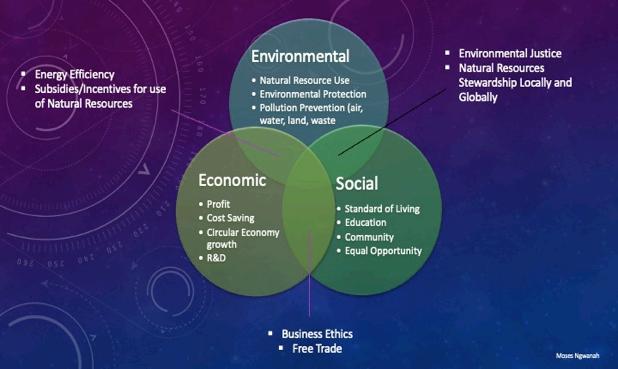
II. Fuel Cells (Electric) and Hydrogen Combustion.
SAF looks very likely to be the most acceptable and adaptable solution given the difficulties related to hydrogen combustion (size and production) and Fuel Cells (capacity and range).
Is the aviation industry in Africa ready?

29 FEATURE
Rolls-Royce powering the Embraer ERJ- a partnership success story
The African aviation market has been underserved for a long time. Before 2020, only 9% of Africa's air traffic was between African countries, the rest being intercontinental. And today, globally, the region accounts for less than 2% of total air traffic despite being home to around 17% of the world’s population.
Africa urgently needs a more extensive and robust aviation network, given the region's relative lack of alternative longdistance transportation infrastructure. Indeed, unlike the United States and Europe, where there is an extensive road and rail network, in Africa, these vital modes of intracontinental transport remain underdeveloped.

“African countries have experienced unprecedented economic growth in the past years, with a fast-growing population,
but the airline industry has not enjoyed the same positive trend. African airlines have been marginalised and this is evidenced by the sharp drop of their market share in the past years. In the intra-African regional market, there is need for airlines to deploy the appropriate right-sized aircraft. As the air transport sector resumes the growth trajectory post-COVID, growth will be enhanced by the implementation of the Single African Air Transport Market (SAATM) and the African Continental Free Trade Agreement (AfFCFTA). A shift of strategies and focus on the regional operations to feed and de-feed major hubs is important for African carriers to harness the growth opportunity and enhance competitiveness.”
Mr. Abderahmane Berthé – AFRAA Secretary General.
30 | African-skies | DECEMBER 2022 FEATURE
While infrastructure is being developed, aircraft manufacturers are also responding to the call. Embraer, in particular, has long seen the potential for its planes in Africa and has thus extensively marketed its aircraft to African airlines.
Rolls-Royce proudly supplies the Brazil-based aircraft manufacturer with AE3007 engines for its 50-seater ERJ family of aircraft. Since the engine achieved FAA/EASA certification in 1995 for Embraer, Rolls-Royce has delivered more than 3,200 engines worldwide, with more than 65 million flight hours. The AE3007 also reliably and efficiently
powers the Cessna Citation X passenger aircraft. In the Defence sector, the AE3007 powers the Northrop Grumman RQ-4A Global Hawk & Triton; in fact, the AE engine family was initially developed for defence applications. Still, the constant development of the common core has given us a range of highly robust and versatile engines.
In Africa, Rolls-Royce powers more than 100 regional aircraft in operation. These range from premium full-serviced regional airlines, government-owned flagship airlines, charter operations, and mining companies to operators serving

humanitarian missions for the United Nations and the World Food Program.
The majority of these aircraft, however, are ERJ 145/140/135 and Legacy twinturbofan regional jets. The Long Range version of the ERJ140 can carry a full load of passengers over a distance of more than 3,000 kilometres. This range can intra-connect Eastern, Central, Western, Southern and Northern African subregions.
As this connectivity increases and barriers to trade and travel are lowered, we expect demand for this aircraft type to grow.
31 FEATURE
Crucial to keeping the Embraer fleet in the air is ensuring as little engine downtime as possible.

During the pandemic, with many aircraft grounded, Rolls-Royce took the opportunity to complete an extensive maintenance program on the AE3007 in the region, upgrading to the latest standards without charge. This allowed operators to comply with an Airworthiness Directive (necessary for all grounded aircraft) before operations restarted, giving them an all-important head start.
Meanwhile, in September 2021, RollsRoyce penned an important extension of its TotalCare service agreement with South African airline Airlink, which happens to be its oldest customer. Covering 28 of the carrier’s aircraft, the 10-year deal marked the continuation of a fruitful agreement which has been in place since Airlink introduced the ERJ 135 into its fleet in 2001.
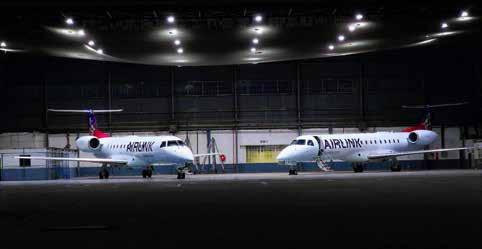
“I’m very proud to say that we have had a long-standing relationship with
Rolls-Royce on TotalCare since 2001. These engines power up our 28-aircraft Embraer ERJ fleet. Rolls-Royce has never dropped the ball, and Airlink has extreme reliability on these engines. Kudos to Rolls-Royce, who has been awarded our supplier of the year and on an unbelievable and excellent relationship.” Rodger Foster, Chief Executive Officer, Managing Director Airlink.
The key to TotalCare is that Rolls-Royce takes back time-on-wing and shop visit cost risks, providing airlines with peace of
mind that their maintenance schedules will run at a fixed cost per engine flying hour. The service is underpinned by predictive maintenance, i.e. fixing problems before they occur. It relies on extensive gathering and analysis of performance data, which helps engineers to diagnose potential future faults and act on them to avoid downtime.
Aircraft covered by TotalCare generally operate at higher levels of availability and retain enhanced long-term value. Meanwhile, users benefit from the global
32 | African-skies | DECEMBER 2022 FEATURE
Image courtesy of Airlink
Image courtesy of Airlink
Rolls-Royce Care Network –an extensive service network that serves engines at every stage of their lifecycle.

Indeed, this has been central to Airlink’s impressive on-time performance, consistently above 97% throughout its use of TotalCare. Today, more than 35% of all ERJ aircraft in Africa are on Rolls-Royce TotalCare engine maintenance agreements – and since the sector emerged from the pandemic, most agreements have been extended.
Moving forwards, if Africa is to build a more extensive regional flying network, maintenance infrastructure will be essential to ensure it runs smoothly. Indeed, Rolls-Royce has observed the need to diversify services to keep as many aircraft flying in the region as possible.
A relentless focus on efficiency and the pathway to zero-emissions
Deploying the right aircraft on suitable routes is also crucial to running the network as environmentally and sustainably as possible.
According to research by Embraer, some 14% of all domestic African flights are operated on widebody aircraft. In addition, the company observes that almost all (99%) of these flights flown with widebodies fly on sectors under 4,500 kilometres – in other words, the scope for narrowbody aircraft seating 120150 passengers to increase operational efficiency is sizeable.
In the longer term, the regional aviation industry has a huge opportunity to be a flagbearer for net zero flying.
And here, as one example in Norway, Embraer and Rolls-Royce, in collaboration
with Widerøe, are deep into a study on a conceptual zero-emission regional aircraft. The 12-month project, set to conclude in February 2023, aims to accelerate the knowledge of the technologies necessary for the net zero transition, progress which could pave the way for clean fuels and electrification to be the significant enablers of a new era of regional aviation. The study examines a variety of potential solutions, including all-electric, hydrogen fuel cell or hydrogen-fuelled gas turbine-powered aircraft.
Meanwhile, Rolls-Royce has submitted a proposal to Embraer to power the new 70-90 seater rear-mounted turboprop that the airframer plans to launch in early 2023. A key reason why Embraer has chosen to switch the design to rear-mounted engines is that it enables easier accommodation of a hydrogen system which could be integrated in the future. With its ongoing R&D into hydrogen-propelled aircraft, Rolls-Royce will be well-placed to fulfil this need.
In addition, the company is set to prove that all its aero engines will be able to run on 100% Sustainable Aviation Fuel by the end of 2023. Any sustainable fuel that meets the D1655 jet fuel standard and requirements is now approved for use in AE3007 engines. Currently, seven different blend varieties can be used, some being certified to blend up to 50% with conventional jet fuel, dramatically reducing carbon footprints.
In keeping its fingers on the pulse, Rolls-Royce is ideally positioned to steer Africa’s growing regional aviation sector in a sustainable direction over the coming years.
33 FEATURE
Author: LCH Consultancy & Associates for Rolls-Royce Civil Aerospace for leading the company into the future
A rewarding journey

Kirsten Rehmann has spent the past 19 years working her way up the career ladder at the airline and ticket distribution company Hahn Air. Having taken on the role of CEO at the start of the year, Regional International speaks to Rehmann on this achievement and her plans for leading the company into the future.
Interview also published in the September/October edition of the ERA magazine “Regional International”
Can you tell us a bit about your career and what led you to this role?
I have been with Hahn Air almost two decades now. Back in 2003, I joined the company when Hahn Air was still a small start-up with a brilliant business idea. Equipped with a diploma in international business administration with the majors tourism and travel, I started as sales and marketing executive. We were only a handful of people in the beginning and as the company grew, I was fortunate to expand my knowledge of aviation distribution by holding various different roles. Hahn Air’s distribution solutions for airlines made the company advance to market leader and, over time, our portfolio grew to more than 350 partner airlines.
As Director of the Airlines Business Group, I was able to support this development by acquiring partner airlines from French speaking markets in Africa and other regions. Later, I moved to the position of Chief Commercial Officer and, in 2012, I joined the corporate management alongside the owners and founders of Hahn Air, Hans Nolte and Nico Gormsen. I am so grateful that they gave me their trust and support and prepared me well for the responsibilities of a future company CEO. In January 2022, I took over the responsibility for the company’s affairs, the global business, as well as operational and strategic planning. Hans Nolte and Nico Gormsen will remain closely connected to Hahn Air in their role as owners.
34 | African-skies | DECEMBER 2022 FEATURE
What initially interested you about the industry and what continues to inspire you day-to-day?
Like everybody working in the airline industry, I have always been fascinated with travel. This fascination grew even more when I started to frequently visit Africa as part of my role in our Airline Business Group. This special love for Africa continues to this day. In addition, I am extremely proud to lead the Hahn Air affairs, as I believe that we provide an important missing link in airline distribution: We connect airlines of any size with travel agents in 190 markets and thereby close distribution gaps for our partners. With our solutions, airlines can sell tickets in markets that they would otherwise not be able to reach through indirect
distribution. As a result, we provide millions of passengers who book through travel agencies with additional travel options. In a nutshell: we connect any airline to the world of indirect distribution, thereby enabling travel to the most remote destinations of this world.
Where do you see the company expanding or focusing its efforts in the next few years and what excites you the most about where the company is headed?

Hahn Air has always been closely monitoring the development of the market, looking for new technologies and distribution opportunities for our partner airlines. The pre-COVID years have been seeing dynamic changes, for example with the advancement of new distribution

35 FEATURE
Author: Kirsten Rehmann, Hahn Air
capabilities. However, the global pandemic has dramatically slowed the progress and has left many market players behind. Especially smaller airlines that were struggling for survival are now more than ever dependent on smart, cost-efficient solutions.
Over the past 20 years, Hahn Air has built an unparalleled connectivity to all distribution and payment systems. In the future, we will leverage on this technology infrastructure, as well as our expertise in ticketing, global payment and distribution strategy to offer alternative and additional retail channels. At the same time, we believe in the importance of GDS sales and will continue to offer our partner airlines reliable access to more than 100,000 travel agencies around the globe. Just recently, we have enhanced our product portfolio with a PSS solution to enable airlines to obtain all components of a successful distribution strategy from a single source.
While I am very excited about the future of the travel industry and all the possibilities it holds, we also need to address a serious issue. The travel industry, like any other industry, needs to take responsibility for its impact on the environment and find sustainable solutions. We have revently formed a partnership with veritree, a technology platform enabling reforestation projects. We committed to planting 150,000 mangrove trees in Kenya and Madagascar. While we realise this is only a first step, we want to contribute to a more sustainable air transport in the future and we are therefore also looking into solutions for our travel agency and airline partners. It is our clear goal to offer carbon compensation options for flights distributed through Hahn Air in the future.

What are your values as a company leader?
I believe in teamwork and I am very fortunate to have a wonderful team at Hahn Air. Many colleagues have been with Hahn Air for a long time already and I am looking forward to shaping the next chapters of Hahn Air together with my team and build future-orientated distribution solutions and ticketing services for our airline and travel agency partners.
As a female leader in aviation, do you hope to inspire more women and girls to enter the industry?
The aviation industry is very much aware of the underrepresentation of women in leadership positions. That’s why IATA is currently driving the 25 by 2025 initiative where airlines commit to increasing the percentage of women in executive roles to at least 25%. Hahn Air is proud to support this initiative. Personally, I would of course be very honoured if I can inspire other female talents to take up a career in aviation. And speaking as a mother of a ten-year-old girl, I can only hope that we are quickly moving towards a future where gender does not define (or even limit) what you can achieve.
36 | African-skies | DECEMBER 2022 FEATURE
Accelerating the pace to aviation net zero carbon emissions

Introduction
Air connectivity brings together people and businesses and serves as essential link between regional communities and the wider world. In Africa, air connectivity has been the main transport mode linking some landlocked and island communities to the world. The importance of these connections became evident during the two critical years of the COVID-19 crisis when travel stalled and trade suffered.
The aviation industry is on a recovery path from COVID-19 and projections are that growth over the next 20 years will be phenomenal. As an industry that has always taken its environmental responsibilities seriously, long-term aspirational goals (LTAG) have been in the works and are now being
concretised. The LTAG comes on the back of much earlier short to medium term environmental change mitigation measures that the industry initiated years back. The industry has developed and is implementing a range of standards, policies and guidance material aircraft noise and emissions, technological improvements, operating procedures, proper organisation of air traffic, appropriate airport and landuse planning, and the use of market-based measures.
IATA and ICAO resolutions aligned with the Paris Agreement
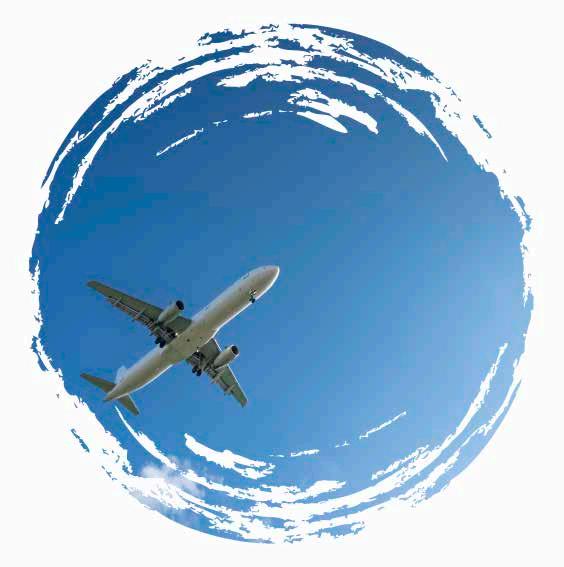
In a resolution passed at the 77th IATA AGM in Boston, USA, on 4 October 2021, the global airline industry committed to achieving net-zero carbon emissions from their operations by 2050.
This bold pledge brings air transport in line with the objectives of the Paris Agreement to limit global warming to 1.5°C. The global civil aviation operations will achieve netzero carbon emissions by 2050, supported by accelerated efficiency measures, energy transition and innovation across the aviation sector and in partnership with Governments around the world.
During the 41st ICAO general assembly in Sep/Oct 2022 a resolution on the longterm aspirational goal (LTAG) of net-zero emissions by 2050 was overwhelmingly adopted by member states. The agreement admitted that special circumstances and capabilities of each country which could influence the outcomes. These factors will determine the ability of a country to achieve the target within its national
37 FEATURE
timeframe. A call for financial and technical support to developing countries for accelerated use of sustainable aviation fuels (SAF) was also endorsed to the pleasure of the developing countries.
ICAO hopes that the net-zero targets will rely on the adoption of new aircraft technologies, streamlined flight operations and the use of SAF. The net-zero resolution also calls for the establishment of a climate finance initiative and voluntary technology transfer for developing SAF.
The alignment of the IATA and ICAO resolutions to the objectives of the Paris Agreement to limit global warming to 1.5°C is probably what the world has been waiting for to make the necessary changes that will make aviation more responsible and sustainable. The road ahead will be challenging, but if we act and support each other as one aviation ecosystem, we can make this a reality.
What does net zero emission really mean?
Put simply, it means removing an equal amount of CO2 from the atmosphere as we release into it. The term net zero applies to a situation where global greenhouse gas emissions from human activity are in balance with emissions

reductions. Net zero does not mean the absence of CO2, rather though CO2 emissions will continue, an equivalent amount of what is generated is removed from the atmosphere, thus resulting in zero increase in net emissions. Achieving net zero by 2050 will require measures aimed at elimination of emissions at the source, offsetting and carbon capture technologies.
AFRAA is convinced that, the aviation industry commitment to net zero CO2 emissions by 2050 would require supportive government policies backing the coordinated efforts of the entire industry (airlines, airports, air navigation service providers, manufacturers).
Contribution of African Aviation Industry to CO2 reduction
The aviation industry focus has always been to progressively reduce emissions while accommodating the growing demand of a population that is eager to fly. The ICAO Carbon Offsetting and Reduction Scheme for International Aviation (CORSIA) is a key enabler of this goal. CORSIA will stabilise international emission levels in the short-to-medium term. The current focus among African airlines is to reduce as much CO2 as possible through investment in new
and modern aircraft, operating more efficiently and investing in smarter airport infrastructure and facilities.
African airlines commitment to sustainable environmental practices are noticeable through operational decisions and policy changes as recommended by IATA and ICAO in the following areas:
• Striving for the most efficient operations – flying more direct routes, aircraft continuous ascent and decent;
• Investing in new and modern aircraft;
• Taking measures to reduce carbon footprint;
• Introducing recycling initiatives at their facilities;
• integrating environmental concerns with all planning and decision making processes;
• Adapting energy and water efficient practices;
• Encouraging improvement in the performance of suppliers through the development of environmental criteria within the framework of procurement policies.
Some 17 African countries have signed up for the voluntary phase of the CORSIA emissions monitoring and reporting. In cooperation with IATA, Ethiopian Airlines, Kenya Airways and South African Airways among others launched Carbon Offset Program that offers customers the opportunity to contribute towards offsetting the CO2 emissions related to their flights. The money raised through these schemes are invested in re-forestation projects in the respective countries. In Ethiopia and Kenya, Boeing is working with the airlines and governments to help the countries develop SAF feedstock production capacity. Boeing is also working with Ethiopian Airlines to include aviation sustainability in the curriculum of the Ethiopian aviation Academy.
38 | African-skies | DECEMBER 2022 FEATURE
In 2016, South African Airways (SAA) was the first African passenger airline to operate a flight using sustainable aviation fuel (SAF). Similar SAF operated flights were subsequently conducted in Ethiopia and Kenya. However, the enthusiasm fizzled out due to lack of incentives and other challenges.
AFRAA, AFCAC, IATA and ICAO have variously organised workshops and seminars aimed at sensitising airlines on the environmental impact of their operations and mitigation measures for sustainability and net zero emissions. These have brought significant awareness on measure to be adopted to improve the situation and build capacity at the operational level.
Milestones towards net zero
Industry prescription for achieving net zero emissions
The transition needed to achieve global net zero emissions must be supported by a holistic government policy framework focused on realising cost effective solutions and backed by the coordinated efforts of the entire industry. The table below by IATA sets out the estimated milestones towards net zero, including the mix of abatement measures and some noteworthy actions envisaged, A commitment of resources, expertise and adherence to the proposed timelines could be the surest way for the industry attaining the ambitious goal on net zero emission by 2050
Author: IATA

97% offsets, 2% SAF, 1% improvements above business as usual (BAU)
ICAO agree long-term goal for international aviation (2022); energy sector commits to at least 6 million tonnes SAF production; agreement of full implementation of Article of Paris Agreement
Use of 100% SAF on aircraft, ANSPs fully implement ICAO Aviation System Block upgrades to deliver fuel efficiency improvements of 0.3% by 2030 2035
1,703 Mt (2031–2035)
93% offsets; 5% SAF, 2% Improvements above BAU
77.5% offsets, 17.5% SAF, 3% improvements above BAU, 2% Carbon Capture Utilisation and Storage (CCUS)
Evolutionary technology achieving 30% reduction in fuel burn, electric/hydrogen aircraft for regional markets (50-100 seats, 30-90 min flights) become available
3,824 Mt (2036-2040)
44.5% offsets, 40% SAF, 7.5% non drop-in fuel (new propulsion technologies), 5% CCUS, 3% improvements above BAU
Feasibility of new aircraft such as blendedwing bodies demonstrated with full-scale working prototypes, electric/hydrogen for short-haul markets (100-150 seats, 45-120 min flights) become available
2045 6,153 Mt (2041-2045)
2050 8,164 Mt (2046-2050)
55% SAF, 24% offsets, 10% non drop-in fuel, 8% CCUS, 3% improvements above BAU
65% SAF, 13% non dropin fuel, 11% CCUS, 8% offsets, 3% improvements above BAU
Necessary infrastructure for new energy requirements (low carbon electricity/hydrogen) becomes available
Commercially viable annual SAF production of 449 billion litres available
39 FEATURE
Date Amount of CO2 abatement Pathway Action 2025 381 megatonnes Mt (2021-2025)
2030 979 Mt (2026-2030)
2040
Source: IATA
South African Airways meets AFRAA Secretary General for the AFRAA CEOs Leadership Dialogues
14 June 2022, Johannesburg
– South Africa: South African Airways (SAA) Chairman & CEO – Mr. John Lamola and Non-Executive Board
Member – Mr. Nick Fadugba, met AFRAA Secretary General, Mr. Abdérahmane Berthé, at SAA headquarters in South Africa for a fruitful “AFRAA Member Airline CEOs Leadership Dialogues” session on Monday, 13 June 2022.

The dialogues session is timely, as SAA forges its path to recovery following a restart of operations in September 2021 that marked the end of the airline’s hiatus which commenced during the COVID-19 pandemic. The deliberations covered various areas of support under the auspices of AFRAA’s initiatives for the development of air transport sector in Africa. Among other issues, the meeting discussed Projects of interest to SAA in the forthcoming AFRAA Laboratory (LAB) that will bring together industry experts and stakeholders to develop relevant project roadmaps that will revamp sustainable aviation & trade development in Africa. The Lab is scheduled to take place from 27 June – 1 July 2022 at the AFRAA headquarters in Nairobi – Kenya.
Speaking at conclusion of the session, Mr. Abdérahmane Berthé, AFRAA Secretary General stated: “AFRAA is pleased for the opportunity to meet SAA leadership for fruitful deliberations
during this edition of the CEO Dialogues session. AFRAA continues to maintain solidarity with its members and African airlines at large to work on initiatives and projects that will develop the aviation sector in Africa, enhance the industry’s competitiveness and grow the global market share.”
“South African Airways has been a major player in the airline industry in Africa whose membership of AFRAA dates to almost three decades. AFRAA will continue to support SAA and our entire membership to emerge stronger and more resilient after the crisis.” Mr. Berthé added.
AFRAA continuously engages the leadership of its member airlines through the CEO Dialogues sessions with the objective to develop transformative initiatives, establish the right fit of added-value projects and actions that will support members’ sustainability.
AFRAA DIARY 40 | African-skies | DECEMBER 2022
AFRAA leads landmark laboratory for the sustainability of the air transport sector in Africa
Experts and key stakeholders from African air transport, trade, and tourism industries converged in Nairobi from 27 June –1 July 2022 at the first-ever African aviation laboratory to develop roadmaps for the sustainability of the air transport sector in Africa.
Led and hosted by AFRAA in collaboration with the African Aviation Group (AAIG), the laboratory’s deliberations were grouped into 5 projects dedicated to seek out-of-the box solutions on specific subject areas, including: fuel and customs taxes, high taxes and charges, navigation – Free Routing Area (FRA), implementation of the Single African Air Transport Market (SAATM) and partnerships between airlines, hospitality and tourism bodies to improve intra-African tourism.
The overall objective of the Laboratory was to address the root cause of challenges facing the air transport industry in Africa and develop relevant solutions to revamp the sector. Africa’s global air traffic market share declined from 3.5% in the early 1980s to 2.5% in 2019, and African airlines’ contribution to this market share plummeted from 45% to 20% in the same period. The COVID-19 pandemic which aggravated the situation of African air transport sector, has seen Africa’s traffic market share drop to less than 2%. This marginalisation trend is a strong wake-up call to all stakeholders to take necessary actions.
Speaking at the closing ceremony of the Laboratory, AFRAA Secretary General, Mr. Abdérahmane Berthé stated: “The Laboratory provides a constructive opportunity to share views and build transformative solutions necessary to address sustainability and competitiveness of Africa’s air transport. AFRAA will continue to spearhead the Laboratory outcomes with the relevant stakeholders to ensure that Africa achieves the survival in the short-term and its sustainability in the long-term.”
At the conclusion of the Laboratory, stakeholders committed to coordinate efforts on the roadmap actions to:
• Increase the number of fifth freedom city pairs in Africa to enhance intra-African connectivity.
• Develop guidelines and economic regulatory framework for rationalization of taxes, charges, and fees.
• Achieve competitive and affordable air travel to boost trade and tourism in Africa.
• Reduce the taxes on fuel and abolish custom duties on spare parts and aircraft in line with the relevant provisions of the ICAO Convention.
• Streamline and automate the flight permits acquisition processes across Civil Aviation Authorities (CAAs).
• Boost flight operation efficiency in African airspace to attain productivity gains for airlines and air navigation service providers.
The roadmap, which will be tabled for adoption by AU Policy Organs shall be monitored, assessed and reviewed by a multi-sectoral steering committee coordinated by AFRAA. The committee shall be composed of the African Union Commission (AUC), the African Civil Aviation Commission (AFCAC), the African Aviation Industry Group (AAIG), African Airlines association (AFRAA), the International Civil Aviation Organisation (ICAO), the International Air Transport Association (IATA), Regional Economic Communities (RECs), DFIs, African Continental Free Trade Area (AfCFTA) Secretariat, ACI Africa, ASECNA, CANSO, the Economic Commission for Africa (UNECA), the Word Tourism Organisation (UNWTO), the African Tourism Board (ATB), Satnav Africa JPO, and African Union of Consumers.
The Laboratory made a call upon states, Development Partners, Financial Institutions and other Stakeholders to support the implementation of the roadmap.
The Laboratory was hosted at the AFRAA Headquarters in Nairobi – Kenya and was attended physically and virtually by 150 participants from AFRAA, African airlines, airports, ACI Africa, Civil Aviation Authorities, Air Navigation Service Providers, AUC, IATA, AFCAC, AAIG, AfCFTA Secretariat, Afreximbank, ASECNA, CANSO, ICAO, UNECA, UNWTO, Tourism Boards, Satnav Africa JPO, the African Union of Consumers, RECs and independent industry experts.
AFRAA DIARY 41
AFRAA-Boeing Airline Economics, Planning & Management Workshop, 15-16 September 2022, Nairobi – Kenya
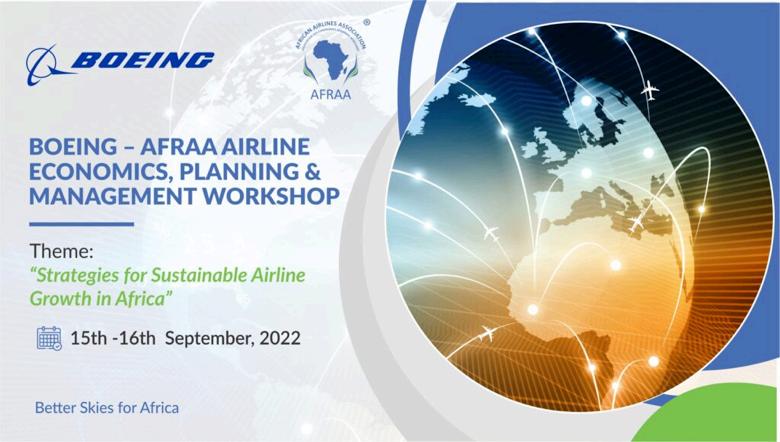
AFRAA, in partnership with Boeing held a Workshop on Airline Economics, Planning & Management from 15-16 September 2022 at the Emara Ole Sereni Hotel in Nairobi – Kenya, inperson format.
Held under the theme: “Strategies for Sustainable Airline Growth in Africa”, the Workshop is an extraordinary airline industry event designed to give African airlines highly-experiential learning,
Event agenda
The AFRAA-Boeing Workshop ran for two days. A detailed agenda can be accessed through this link: AFRAA – Boeing Airline Economics, Planning & Management Workshop –Agenda AFRAA Secretariat hereby invited representatives of the following functional areas airlines to participate:
with a clear focus on the underlying dynamics and decision drivers that influence the airline business. Participants will gain a global perspective on airline strategy, planning and management to enhance understanding of airline operations. This workshop is an amazing opportunity to hear from the world’s leading aircraft manufacturer while spending time in a learning environment and networking with peers from airlines around the continent.
• Fleet management
• Revenue management and revenue planning
• Airline economics
• Airline operations or strategy.
AFRAA Secretary General meets air transport stakeholders in Uganda
AFRAA Secretary General – Mr. Abdérahmane Berthé, met the minister of Works and Transport of Uganda, Hon. Gen Edward Katumba Wamala and the Chief Executive Officer of Uganda Airlines – Ms. Jenifer Bamuturaki on 22-23 August 2022. During the visit, Mr. Berthé addressed stakeholders and media in Uganda on 22 August on the state of the airline industry,
ongoing initiatives in place to address sustainability of air transport in Africa and the 2023 AFRAA Annual General Assembly (AGA) scheduled to be held in Uganda under the patronage of the Ministry of Works and Transport at the kind invitation of Uganda Airlines.
AFRAA DIARY 42 | African-skies | DECEMBER 2022
Notably, on sustainability of air transport industry in Africa, Mr. Berthé highlighted the AFRAA-led industry Laboratory developed a roadmap to redress the marginalisation of African airline industry by addressing the challenges facing the sector. The roadmap, which will be tabled for adoption by AU Policy Organs, is structured into 5 projects with targets, strategies, specific actions for each strategy. The projects include:
• Fuel and customs taxes
• High taxes and charges
• Navigation – Free Routing Area (FRA)
• Implementation of the Single African Air Transport Market (SAATM)
• Partnerships between airlines, hospitality and tourism bodies to improve intra-African tourism.
AFRAA envisions a sustainable, interconnected and affordable Air Transport industry in Africa where African Airlines become key players and drivers to African economic development.
“We will continue to spearhead the Laboratory outcomes with the relevant stakeholders to ensure that Africa achieves the survival in the short-term and its sustainability in the long-term.” Mr. Berthé stated.
Senegal meets AFRAA ahead of hosting the premier gathering of aviation leaders in December 2022
The Minister of Tourism and Air Transport of the Republic of Senegal, Alioune Sarr, met AFRAA Secretary General –Mr. Abderahmane Berthé and Air Senegal CEO – Mr. Alioune Badara Fall, ahead of the country’s hosting of the 54th Annual General Assembly (AGA) and Summit of the African Airlines Association (AFRAA) in December 2022. The 54th AFRAA AGA will be held under the high patronage of the Head of State of the Republic of Senegal from 11-13 December 2022 at the Centre International de Conférences Abdou Diouf (CICAD) at the kind invitation of Air Senegal.
During the visit, Mr. Berthé, Alioune Sarr and Mr. Fall deliberated on the state of the airline industry in the country, priorities and plans for the development of the sector, initiatives by AFRAA to address the sustainability of air transport in Africa and the milestones for the staging of the AFRAA AGA.
Addressing a press conference held in Dakar during the visit, Mr. Berthé stated: “AFRAA is pleased to convene top leaders of the air transport industry from across the globe for the Assembly in physical format in Senegal. Deliberations at this year’s Assembly AGA will focus on the theme: “Acing the Roadmap to Sustainable African Aviation”. This will better prepare stakeholders to continue to rebuild Africa’s aviation to make the travel ecosystem more resilient and viable. The Assembly is therefore a critical forum for us to create the much-needed enabling environment for air transport business to thrive and contribute to the continent’s development.
The CEO of Air Senegal, Mr. Alioune Badara Fall stated: “On behalf of his Excellency the President of the Republic
of Senegal and the Minister of Tourism and Air Transport, Air Senegal would like to thank AFRAA for choosing Senegal to host its 54th AGA. Hosting the African air transport leaders in Dakar since the advent of the COVID-19 health crisis is special as it offers us a great opportunity to get together again to share our various experiences. We are getting ready to make it a historic summit, one of renewed hope for our sector. There is a lot of potential for African aviation and we need a synergy of actions to release this potential to bring more efficiency to the sector in order to make it sustainable”.
In addition to providing an excellent platform for brand visibility through sponsorship, the General Assembly and Summit of AFRAA will present exhibition opportunities for aviation companies to showcase their services, equipment, components, supplies, and IT solutions. The 54th AFRAA AGA will be attended by Chairmen and CEOs from African airlines, ICAO, IATA, AFCAC, civil aviation authorities, airport companies, air navigation services providers as well as aircraft and engine manufacturers, component suppliers, and many other service providers.
This annual biggest gathering of African airline CEOs was last held in-person format in Mauritius in 2019 and is expected to attract over 500 high profile delegates from the aviation industry in Africa, Europe, the Middle East, Asia and North America. “AFRAA and Air Senegal are dedicated to ensuring that the air transport industry stakeholders will experience yet another memorable AGA this year in Senegal – the country of Teranga “great hospitality” added Mr. Berthé.
AFRAA DIARY 43
AFRAA Secretary General remarks at the Aviation Africa Conference in Kigali, Rwanda

African Airlines passenger traffic dropped 60.2% in 2020 due to the COVID-19. By 2021 the activity is recovering. In August 2022, the traffic reached 77.2% of the 2019 level. However, we are not yet at the levels of 2019.
The Passenger Revenue Losses for 2021 were USD 8.6 billion, representing 49.8% of 2019 revenues. We estimate the same at USD 3.5 billion for 2022.
The average loss per passenger carried in 2022 is estimated at 7.9 USD by IATA.
The percentage of international routes operated by African airlines compared to Feb 2020 reached 98.7% in August 2022. However, connectivity is still low in Africa. Currently, up to 22% of Africans traveling between two African cities are forced to travel through non-Africa HUBs either in Europe or the Middle East. This situation can be reversed only through Networks and Schedules Coordination at African hubs.
Connectivity is intricately aligned to trade, business development, and tourism. Currently, the Intra-Africa trade is modest at 18%, which is very low compared to Europe (64%) or Asia, which is above 50%
Indeed, there are no significant Intra-Africa tourism flows.
If there is no Intra-African trade, business, and tourism development, any traffic growth will strengthen the existing routes and will not serve the intra-Africa connectivity. At AFRAA, our vision is “a sustainable, interconnected and
affordable Air Transport industry in Africa where African Airlines become key players and drivers to African economic development.”
We believe stakeholders’ engagement and commitment are vital drivers to transform the industry.
The first Laboratory on Air Transport Sustainability in Africa was held from 27 June to 1 July 2022 at the AFRAA headquarters in Nairobi, Kenya. The LAB was necessitated by the urgent need to stop the marginalisation of African airlines, restore industry competitiveness, re-gain and retain Intra-Africa traffic and grow Africa’s global market share.
The one-week event brought together air transport, trade, and tourism stakeholders from across Africa to develop a roadmap for the sustainability of the African air transport industry.
At the end of five days of stocktaking, critical analysis, prognosis, and consensus building, the LAB developed a roadmap with specific actions assigned to stakeholder organisations, with defined timelines for execution. The roadmaps also contained implementation monitoring mechanisms and expected benefits upon complete execution.
A Steering Committee co-chaired by AFRAA and AFCAC, made up of all relevant stakeholder organisations in aviation, trade, tourism, and DFIs will oversee the implementation of the roadmap. AFRAA remains dedicated to steer the actualisation of the roadmap which will change the narrative of African aviation.
AFRAA and Flight Safety Foundation Sign MoU for collaboration to enhance safety of the air transport industry in Africa

The African Airlines Association (AFRAA) and Flight Safety Foundation (FSF) signed a memorandum of understanding (MoU) to establish a framework of cooperation and facilitate collaboration between the two organisations on actions to enhance air transport safety in Africa.
Under the MoU, AFRAA and FSF will cooperate closely and consult each other on matters and/or activities of mutual interest aimed at the improvement of safety of the air transport industry in Africa such as joint regional technical workshops, development of information and resource material for the
Better Skies for Africa
AFRAA DIARY 44 | African-skies | DECEMBER 2022
membership of each organisation and the industry at large, promotion of effective safety information sharing among other initiatives.
Mr. Abderahmane Berthé – AFRAA Secretary General, and Dr. Shahidi – President and CEO of FSF, signed the MoU at the side-lines of the Aviation Africa conference in Kigali – Rwanda. On the signing ceremony, AFRAA Secretary General Mr. Abdérahmane Berthé stated: Safety is among AFRAA’s top priorities and the driving force behind our championing regional safety coordination for Better Skies in Africa. For African aviation to yield better safety performance, the continued coordinated efforts by aviation stakeholders are essential in line with the
five pillars: cooperative approach to safety improvement in Africa under the framework of the Abuja Safety Targets, operational compliance of African carriers with International standards, data-driven safety management, infrastructure safety, and fleet modernisation.”
“We are excited to establish a framework of collaboration with Flight Safety Foundation that will enhance actions under the five pillars and positively impact air transport contribution to Africa’s economic development.” Mr Berthé added.
Dr. Shahidi – President and CEO of FSF on his part stated:
“I look forward to collaboration with AFRAA to work together to advance aviation safety in Africa.”
AFRAA forges close engagement with Nigerian Member airlines through CEOs Leadership Dialogues
The Secretary General of the African Airlines Association (AFRAA), Mr. Abdérahmane Berthé, in a bid to foster closer engagement with member airlines in Nigeria, met the CEO of Air Peace, Barr. Allen Onyema, the CEO of Allied Air –Capt. Valentine Tongo and the CEO of Overland Airways –Capt. Edward Boyo for “AFRAA Member Airline CEOs Leadership Dialogues” at the respective airlines’ head-offices. The CEO Dialogues initiative was launched in 2022 as part of AFRAA’s strategy to engage with member’s leadership to create dialogue that is necessary to enhance value addition of the Association to better meet its members’ needs.
AFRAA Secretary General further had a meeting with the Vice President of Airline Operator of Nigeria (AON) – Barr. Allen Onyema to discuss their Associations’ mutual areas of interest and support to airlines in Nigeria. The issues covered in the deliberations included: priorities for the recovery of the airline industry, sustainability of airlines, challenges being faced by Nigerian operators and the establishment of a coordination mechanism between AFRAA and AON to enhance advocacy efforts.
At the conclusion of the CEO’s Dialogue sessions, Mr. Abdérahmane Berthé, stated: “It’s a great pleasure for AFRAA to meet today with our three Nigerian members that joined the Association between 2018-2019. Nigeria is a key
market for the African air transport which is ranked at 8th position out of 54 in terms of the number of intra African passengers that are estimated at 1.1 million according to IATA statistics. The market has a huge potential for growth and economic contribution. Today’s deliberations have been fruitful and critical to align our actions for our member airlines in Nigeria and give the support within our mandate to drive the development of the air transport sector.
“With this initiative, AFRAA aims to facilitate better understanding of individual airline needs, local matters and challenges, priorities and business plans thereby enabling us tailor specific actions that enhance relevance of the Association to our membership.” Mr. Berthé added.
The CEO’s Dialogues are continuous, round-the-year sessions that engage the Member airlines’ decision makers with AFRAA leadership towards effective implementation of added-value projects and actions supporting members’ sustainability.
AFRAA’s actions are anchored on five pillars including:
1. Safe, secure and reliable air transport
2. Visibility, reputation and influence of African Airlines
3. Sustainable air transport
4. Cooperation
5. Data intelligence.
AFRAA DIARY 45
AFRAA
Secretary General meets Ethiopian Airlines Group CEO for AFRAA’s CEOs Leadership Dialogues
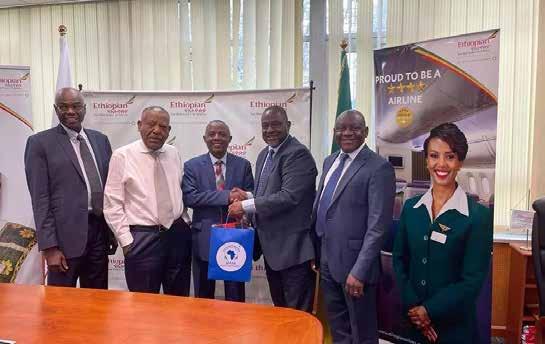
As part of AFRAA’s strategy to forge a close relationship with its member airlines, the Secretary General of AFRAA, Mr. Abdérahmane Berthé, met Ethiopian Airlines Group Chief Executive Officer, Mr. Mesfin Tasew Bekele for another edition of the “AFRAA Member Airline CEOs Leadership Dialogues at Ethiopian Airlines headquarters in Addis Ababa, Ethiopia. Ethiopian Airlines Group CEO was accompanied by: Mr. Girma Wake – the Board Chairman, and Mr. Ahadu Simachew –Manager, Group Alliances, Commercial Cooperation & Industry Affairs.
The meeting discussed in details various industry developments and priorities for advocacy on factors affecting the sustainability of the air transport sector, notably: taxes and charges, currency repatriation, and the implementation of the Single African Air Transport Market (SAATM). The Secretariat made an exposé of AFRAA projects of value-addition to members to facilitate an understanding of the benefits and effectiveness of projects of interest to Ethiopian Airlines.
At the conclusion of the CEO’s Dialogue session, Mr. Abdérahmane Berthé, AFRAA Secretary General said:
“AFRAA is pleased to meet Ethiopian Airlines – one of AFRAA’s founding member airlines – for the CEOs Dialogues. Today’s discussions have facilitated an opportunity for a close connection between AFRAA and Ethiopian Airlines and culminated in a better understanding of Ethiopian Airlines’ priorities vis-a-vis AFRAA’s mandate.”
“We will continue to tailor our actions to enhance the relevance of the Association to our membership. I look forward to a continued mutually beneficial working relationship with Ethiopian Airlines and the entire AFRAA fraternity at large.” Mr. Berthé added.
Through the CEO’s Dialogues initiative, AFRAA has engaged seven of its Member airlines in 2022 towards effective implementation of added-value projects and actions supporting members’ sustainability.
AFRAA Secretariat Teamleaders who were present during the deliberations with Ethiopian Airlines included: Mr. Gaoussou Konate – Director Technical & Operations and Mr. Raphael Kuuchi – Director Government, Legal & Industry Affairs.
46 | African-skies | DECEMBER 2022 AFRAA DIARY
Training Conducted in 2022
1. Aviation Internal Auditor Course
AFRAA conducted a Virtual Aviation Internal Auditor Course for Camair-co on 21-24 March 2022 where 20 participants attended the training. This course prepared participants to conduct consistent audits and drive continuous improvement within their organisation. They learnt about the audit process through a breakdown of its stages: the audit scope, objectives, follow-up and closing; and practice using techniques that deliver objective, measurable results. International audit requirements were covered in detail followed by a hands-on practical component
2. Instructional Techniques Course
AFRAA conducted an Instructional Techniques course for Jambojet on 18-22 July 2022. This course was held at AFRAA Headquarters, Nairobi –Kenya where 14 participants attended the training. Through this course the participants were able to define and implement the basic rules of good Instructional Techniques, demonstrate how to effectively prepare for start, conduct and wrap-up a training event, apply basic principles of learning and active training and demonstrate appropriate instructional techniques.
3. Root Cause Analysis Course
The Root Cause Analysis Course was held virtually on 11-14 October 2022. At the end of the course, the participants were able to use Problem Identification Tools, Identify Problems and apply root cause analysis principles and Complete Root Cause Analysis required for IOSA.

Sponsored Courses by Boeing AFRAA in partnership with Boeing held 3 courses this year:
i. Advanced Safety Management Systems Course held virtually on 20-24 June 2022
ii. Quality Management Systems Course held virtually on 5-9 September 2022
iii. Dangerous Goods Category 6 Initial Course held virtually on 19-23 September 2022 Boeing proudly sponsored these trainings as part of their initiative to promote a safety culture within the continent. The training attracted participants from various airlines in Africa who gained effective skills that would help in their execution of day-to-day activities within the airline.
Upcoming Courses
Please contact Dicie Okaya (training@afraa.org) on how to register for the courses
In-House Trainings
AFRAA offers in-house trainings that cater for the unique training needs within your airline. This tailor-made courses are normally designed in a way that all participants from an airline benefit from the course consequently increasing productivity of the airline in a holistic way.
For an in-house course, please contact Dicie Okaya (training@afraa.org)
Course Date Mode Strategic Planning and Leadership 17th-19th October Virtual Dangerous Goods Regulations Refresher CAT 8,9,10,11, 12 24th October Virtual Finance for Non-Finance Managers/Budgeting 1-4 November Virtual
Instructional Techniques Course, 18-22 July at AFRAA Headquarters, Nairobi – Kenya
47 AFRAA DIARY
Capacity Building Workshops
1. Boeing – AFRAA Airline Economics, Planning and Management Workshop
AFRAA, in collaboration with Boeing, held an Airline Economics, Planning and Management Workshop on 15-16 September at the Emara Ole Sereni Hotel in Nairobi – Kenya.

Held under the theme, “Strategies for Sustainable Airline Growth in Africa”, the workshop gave African Airline highly-experiential learnng, with a clear focus on the underlying dynamics and decisión drivers that influence airline Business.
Participants gained expert insights on airline strategy, planning, and management to enhance their understanding of airline Operations in a learning environment and networking with peers from airlines around the continent.
2. Route Planning: Airlines and Airports Perspective
The African airlines association facilitated a Route Planning Workshop from 12-13 March 2022 during the 67th ACI Africa Regional Conference.
Route Planning is critical for airports and airlines, as it plays a major part in the overall organisational strategy. In these unprecedented times, Route Planning is a vital component for the recovery of the air transport sector. The workshop equipped over 80 participants with insights on the best industry practices for route planning from an airport and an airline perspective. Specific modules covered included:
i. The fundamentals of the airline business.
ii. Key drivers for successful route planning with practical examples.
iii. Methods for evaluating routes, forecasting of costs & profitability, and planning for the future adjustments.
iv. Airline commercial strategies for marketing, distribution, revenue management & pricing and interlining.
v. Factors to consider for Flight Operations, Ground Operations and Line Maintenance.
vi. How to market and launch a new route.
Facilitators:
• Mr. Abdérahmane Berthé, AFRAA Secretary General
• Mr. Gaoussou Konate, AFRAA Director Technical & Operations
• Ms. Maureen Kahonge, AFRAA Senior Manager Business Development & Communications.
48 | African-skies | DECEMBER 2022 FEATURE
Boeing – AFRAA Airline Economics, Planning and Management Workshop, 15-16 September, Nairobi - Kenya
African Skies section on state of the industry
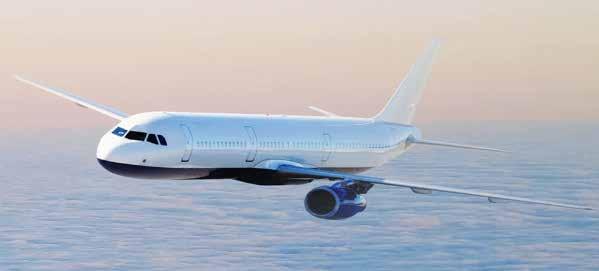
worldwide
Waves of infection worldwide
Weekly evolution of infections cases per region as of 24 September 2022
Most impacted countries in Africa
• While Asia is reopening and easing the restrictions linked to COVID-19, Europe fears the occurrence of the 8th wave of contamination. UK has reported a rise in contamination, which had not been the case since July. In Africa, the number of new contaminations remains low.
§ While Asia is reopening and easing the restrictions linked to the Covid, Europe fears the occurrence of the 8th wave of contamination. UK has reported a rise in contamination, which had not been the case since July.
In Africa, the number of new contaminations remains low.
§ Worldwide, the number of cases has reached 619 million and 12.6 million in Africa. The recovery rate is 98.9% worldwide compared to 98% in Africa.
• Worldwide, the number of cases have reached 619 million and 12.6 million in Africa. The recovery rate is 98.9% worldwide compared to 98% in Africa.
infection
Waves of
0 2 4 6 8 10 12 2020-01 2020-05 2020-09 2020-13 2020-17 2020-21 2020-25 2020-29 2020-33 2020-37 2020-41 2020-45 2020-49 2020-53 2021-04 2021-08 2021-12 2021-16 2021-20 2021-24 2021-28 2021-32 2021-36 2021-40 2021-44 2021-48 2021-52 2022-03 2022-07 2022-11 2022-15 2022-19 2022-23 2022-27 2022-31 2022-35 Million new cases America Asia Europe 0 100 200 300 400 500 600 700 800 2020-01 2020-05 2020-09 2020-13 2020-17 2020-21 2020-25 2020-29 2020-33 2020-37 2020-41 2020-45 2020-49 2020-53 2021-04 2021-08 2021-12 2021-16 2021-20 2021-24 2021-28 2021-32 2021-36 2021-40 2021-44 2021-48 2021-52 2022-03 2022-07 2022-11 2022-15 2022-19 2022-23 2022-27 2022-31 2022-35 Thousand new cases Africa Middle-East Oceania 0 10 20 30 40 50 60 70 80 90 100 110 0 500 1000 1500 2000 2500 3000 3500 4000 South Africa Morocco Tunisia Egypt Libya Ethiopia Réunion Kenya Zambia Botswana Thousand Thousand Cases Recoveries Deaths
Source: Worldometer
0 2 4 6 8 10 12 2020-01 2020-05 2020-09 2020-13 2020-17 2020-21 2020-25 2020-29 2020-33 2020-37 2020-41 2020-45 2020-49 2020-53 2021-04 2021-08 2021-12 2021-16 2021-20 2021-24 2021-28 2021-32 2021-36 2021-40 2021-44 2021-48 2021-52 2022-03 2022-07 2022-11 2022-15 2022-19 2022-23 2022-27 2022-31 2022-35 Million new cases America Asia Europe 0 100 200 300 400 500 600 700 800 2020-01 2020-05 2020-09 2020-13 2020-17 2020-21 2020-25 2020-29 2020-33 2020-37 2020-41 2020-45 2020-49 2020-53 2021-04 2021-08 2021-12 2021-16 2021-20 2021-24 2021-28 2021-32 2021-36 2021-40 2021-44 2021-48 2021-52 2022-03 2022-07 2022-11 2022-15 2022-19 2022-23 2022-27 2022-31 Thousand new cases Africa Middle-East Oceania 0 10 20 30 40 50 60 70 80 90 100 110 0 500 1000 1500 2000 2500 3000 3500 4000 South Africa Morocco Tunisia Egypt Libya Ethiopia Réunion Kenya Zambia Botswana Thousand Thousand Cases Recoveries Deaths 49 STATS
Capacity and traffic evolution
Capacity anf traffic evolution
• In August 2022, the capacity reached 79.7% of the 2019 level and traffic 80.7%.
• Domestic traffic was dominant in July 2022 with 39.5% of the seats offered and 32.8% of the passengers carried.
• In August 2022, the capacity reached 79.7% of the 2019 level and traffic to 80.7%.
• This is estimated to increase in September. Traffic is will reach 82.52% and capacity 82.1% of 2019 levels.
• This is estimated to increase in September. Traffic is will reach 82.52% and capacity 82.1% of 2019 levels.
International routes
• Domestic traffic was dominant in July 2022 with 39.5% of the seats offered and 32.8% of the passengers carried
• Intra-African passengers carried represented 29.5% of the total passengers while the seats offered represented 24%.
• Intra-African passengers carried represented 29.5% of the total passengers while the seats offered represented 24%.
• Intercontinental traffic was 37.6% of the passengers carried and 36.5% of the seats offered.
• Intercontinental traffic was 37.6% of the passengers carried and 36.5% of the seats offered.
The percentage of international routes operated by African airlines compared to Feb 2020 reached 99.2% in September 2022, compared to 98.7% in August.
Ethiopian airlines have opened new intra-African 5th freedom routes. Royal Air Maroc and EgyptAir also reopened some previously closed routes. 8 airlines in this top 15 have reached or exceeded their number of international routes of the pre-COVID period.
0 5 10 15 20 25 Jan Feb Mar Apr May Jun Jul Aug Sep Oct Nov Dec Jan Feb Mar Apr May Jun Jul Aug Sep Oct Nov Dec Jan Feb Mar Apr May Jun Jul (est.) Aug (est.) Sep (est.) Billion RPKs 2019 2020-22
Source : AFRAA/OAG
0 5 10 15 20 25 Jan Feb Mar Apr May Jun Jul Aug Sep Oct Nov Dec Jan Feb Mar Apr May Jun Jul Aug Sep Oct Nov Dec Jan Feb Mar Apr May Jun Jul (est.) Aug (est.) Sep (est.) Billion RPKs 2019 2020-22 0 2 4 6 8 10 12 14 Seats Passengers Millions Intercontinental Intra African Domestic 0 2 4 6 8 10 12 14 Seats Passengers Millions Intercontinental Intra African Domestic Millions 0 50 100 150 200 250 Ethiopian Airlines Royal Air Maroc Egyptair Nouvelair Tunisair Air Algerie Air Cairo Air Arabia Maroc Kenya Airways ASKY Airlines SA Airlink Rwandair Air Arabia Egypt Nile Air Air Cote d'Ivoire Jul-22 Aug-22 Sep-22 Feb-20
50 | African-skies | DECEMBER 2022 STATS
The Intra-African connectivity reached 81% of the pre-covid level in August 2022. It is estimated to increase to 89% in September.
The connectivity improved in west and central African airports
The Intra-African connectivity reached 81% of the pre-COVID level in August 2022. It is estimated to increase to 89% in September
The connectivity in Mauritius is also improving as the country as reopened routes to Africa, Asia and Europe.
The connectivity improved in west and central African airports.
The connectivity in Mauritius is also improving as the country as reopened routes to Africa, Asia and Europe.
Passenger
estimate due to COVID for African airlines
Quaterly Revenue Loss
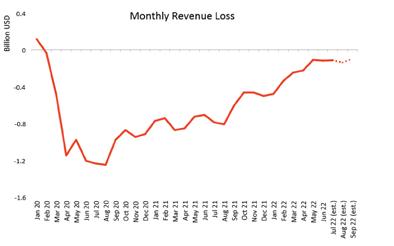
• Estimated Revenue loss for 2022 USD 3.5 billion, representing 20% of 2019 revenues.
• Estimated Revenue loss for Q3 2022: USD 0.8 billion
Intra-african
-1 -0.8 -0.6 -0.4 -0.2 0 0.2 0.4 Casablanca Cairo 4Khartoum Algiers Lagos Dakar Abidjan Lome Libreville Ndjamena Douala Nairobi Kigali Addis Ababa Entebbe 4Lilongwe Luanda Mauritius Johannesburg Δ Sep22/Feb20
revenue loss
connectivity
Dakar Abidjan Lome Libreville Ndjamena Douala Nairobi Kigali Addis Ababa Entebbe Lilongwe Luanda Mauritius Johannesburg -4 -3 -2 -1 0 Q1 2020 Q2 2020 Q3 2020 Q4 2020 Q1 2021 Q2 2021 Q3 2021 Q4 2021 Q1 2022 Q2 2022 Q3 2022 Q4 2022 Billion USD
Source : AFRAA/OAG
51 STATS

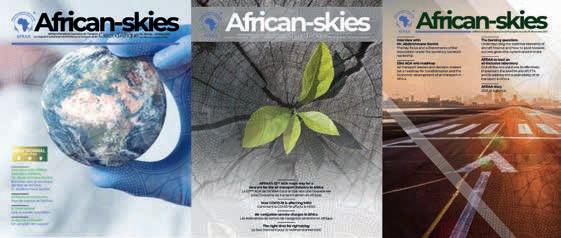
Who reads African-skies online? ADVERTISE IN CEOs/COOs | Presidents | CIOs | General Managers | Vice Presidents Technical/Maintenance Directors | Flight Operations Directors Chief Pilots | Chief Flight Attendants | Procurement/Contract O icers Passenger Service Directors | Marketing O icers | Cargo Directors Non-African Airlines | Regional Directors | Alliance/Partnership Directors Airports Directors | Marketing Directors | Facility Managers Airline Passengers | Government Ministries and Agencies Ministers | Agency/Department Sta | Leaders | Certification/Authorisation Regulators Associations | Secretary Generals Business Development Managers | Airline Industrial Partners To advertise, please contact Email: rukhsana@camerapix.co.ke or mkahonge@afraa.org Cell: +254 739 265 511 | Tel: +254 20 4442923/4/5














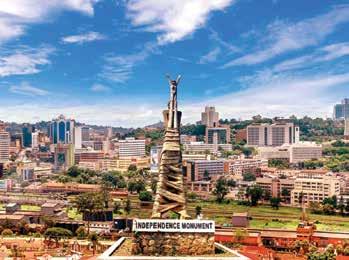






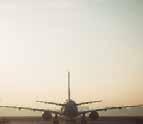
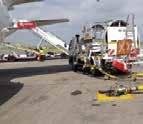

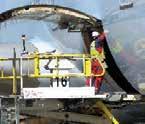
Our areas of exper tise: Airline Restructuring | Technical & Operations | Training | Safety Finance | Commercial | Aviation Policy | Master Plans Contacts us • Cost effective consulting services; • Tailored solutions from experts who understand the African context; • High quality deliverables; • Contribution to improve air transport sustainability in Africa. Af rican Airlines Association (AFRAA) P O Box 20116 Nairobi 00200 - Kenya Email: consulting@af raa org Tel: +254 20 23 20 144 / 23 20 148 Office Mobile: +254 722 209708, Website: www af raa org



 AFRAA’s
AFRAA’s

























 Author: AFRAA
Author: AFRAA






















































































